BUSN20016 research in Business
VerifiedAdded on 2021/06/14
|19
|5295
|126
AI Summary
Contribute Materials
Your contribution can guide someone’s learning journey. Share your
documents today.
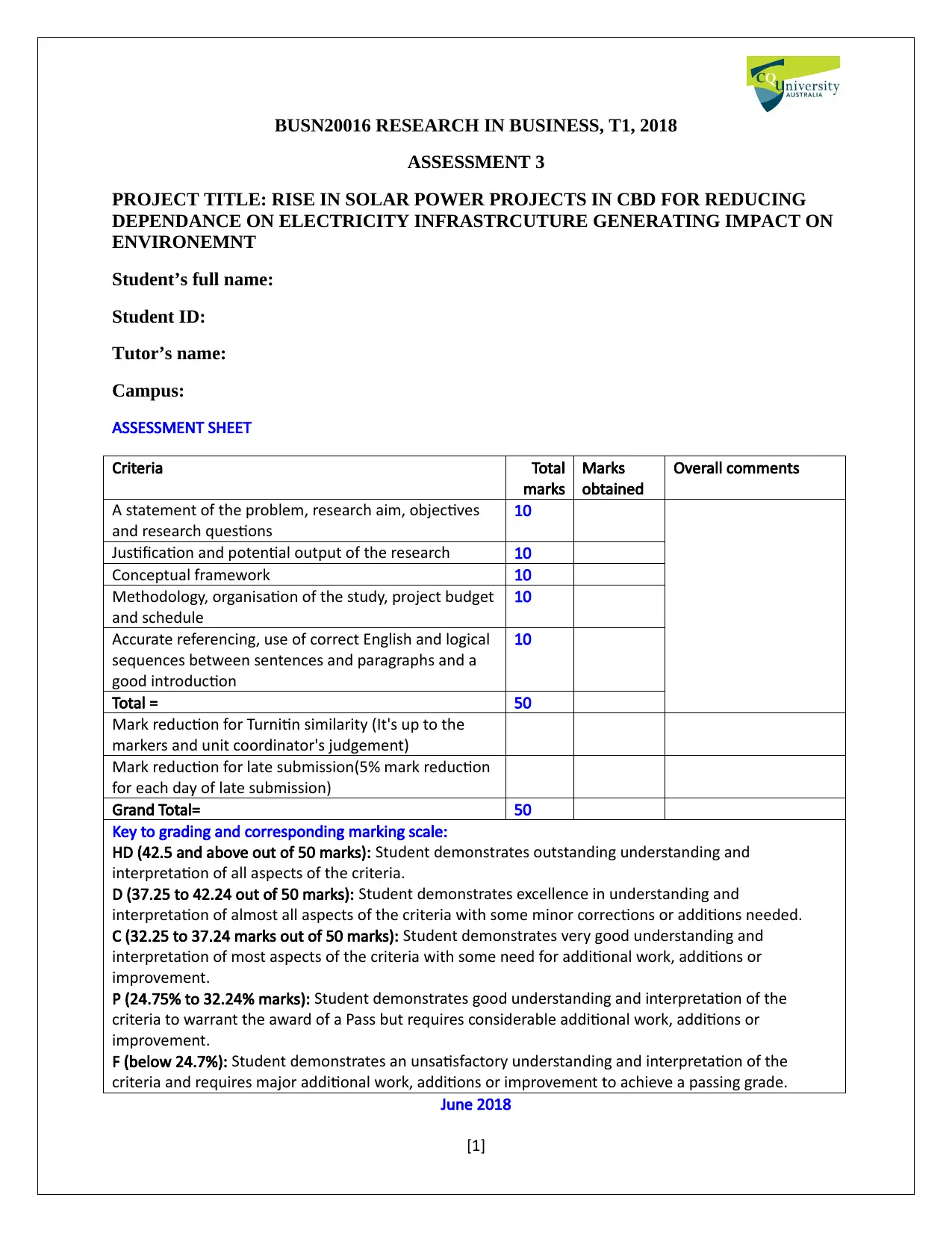
BUSN20016 RESEARCH IN BUSINESS, T1, 2018
ASSESSMENT 3
PROJECT TITLE: RISE IN SOLAR POWER PROJECTS IN CBD FOR REDUCING
DEPENDANCE ON ELECTRICITY INFRASTRCUTURE GENERATING IMPACT ON
ENVIRONEMNT
Student’s full name:
Student ID:
Tutor’s name:
Campus:
ASSESSMENT SHEET
Criteria Total
marks
Marks
obtained
Overall comments
A statement of the problem, research aim, objectives
and research questions
10
Justification and potential output of the research 10
Conceptual framework 10
Methodology, organisation of the study, project budget
and schedule
10
Accurate referencing, use of correct English and logical
sequences between sentences and paragraphs and a
good introduction
10
Total = 50
Mark reduction for Turnitin similarity (It's up to the
markers and unit coordinator's judgement)
Mark reduction for late submission(5% mark reduction
for each day of late submission)
Grand Total= 50
Key to grading and corresponding marking scale:
HD (42.5 and above out of 50 marks): Student demonstrates outstanding understanding and
interpretation of all aspects of the criteria.
D (37.25 to 42.24 out of 50 marks): Student demonstrates excellence in understanding and
interpretation of almost all aspects of the criteria with some minor corrections or additions needed.
C (32.25 to 37.24 marks out of 50 marks): Student demonstrates very good understanding and
interpretation of most aspects of the criteria with some need for additional work, additions or
improvement.
P (24.75% to 32.24% marks): Student demonstrates good understanding and interpretation of the
criteria to warrant the award of a Pass but requires considerable additional work, additions or
improvement.
F (below 24.7%): Student demonstrates an unsatisfactory understanding and interpretation of the
criteria and requires major additional work, additions or improvement to achieve a passing grade.
June 2018
[1]
ASSESSMENT 3
PROJECT TITLE: RISE IN SOLAR POWER PROJECTS IN CBD FOR REDUCING
DEPENDANCE ON ELECTRICITY INFRASTRCUTURE GENERATING IMPACT ON
ENVIRONEMNT
Student’s full name:
Student ID:
Tutor’s name:
Campus:
ASSESSMENT SHEET
Criteria Total
marks
Marks
obtained
Overall comments
A statement of the problem, research aim, objectives
and research questions
10
Justification and potential output of the research 10
Conceptual framework 10
Methodology, organisation of the study, project budget
and schedule
10
Accurate referencing, use of correct English and logical
sequences between sentences and paragraphs and a
good introduction
10
Total = 50
Mark reduction for Turnitin similarity (It's up to the
markers and unit coordinator's judgement)
Mark reduction for late submission(5% mark reduction
for each day of late submission)
Grand Total= 50
Key to grading and corresponding marking scale:
HD (42.5 and above out of 50 marks): Student demonstrates outstanding understanding and
interpretation of all aspects of the criteria.
D (37.25 to 42.24 out of 50 marks): Student demonstrates excellence in understanding and
interpretation of almost all aspects of the criteria with some minor corrections or additions needed.
C (32.25 to 37.24 marks out of 50 marks): Student demonstrates very good understanding and
interpretation of most aspects of the criteria with some need for additional work, additions or
improvement.
P (24.75% to 32.24% marks): Student demonstrates good understanding and interpretation of the
criteria to warrant the award of a Pass but requires considerable additional work, additions or
improvement.
F (below 24.7%): Student demonstrates an unsatisfactory understanding and interpretation of the
criteria and requires major additional work, additions or improvement to achieve a passing grade.
June 2018
[1]
Secure Best Marks with AI Grader
Need help grading? Try our AI Grader for instant feedback on your assignments.
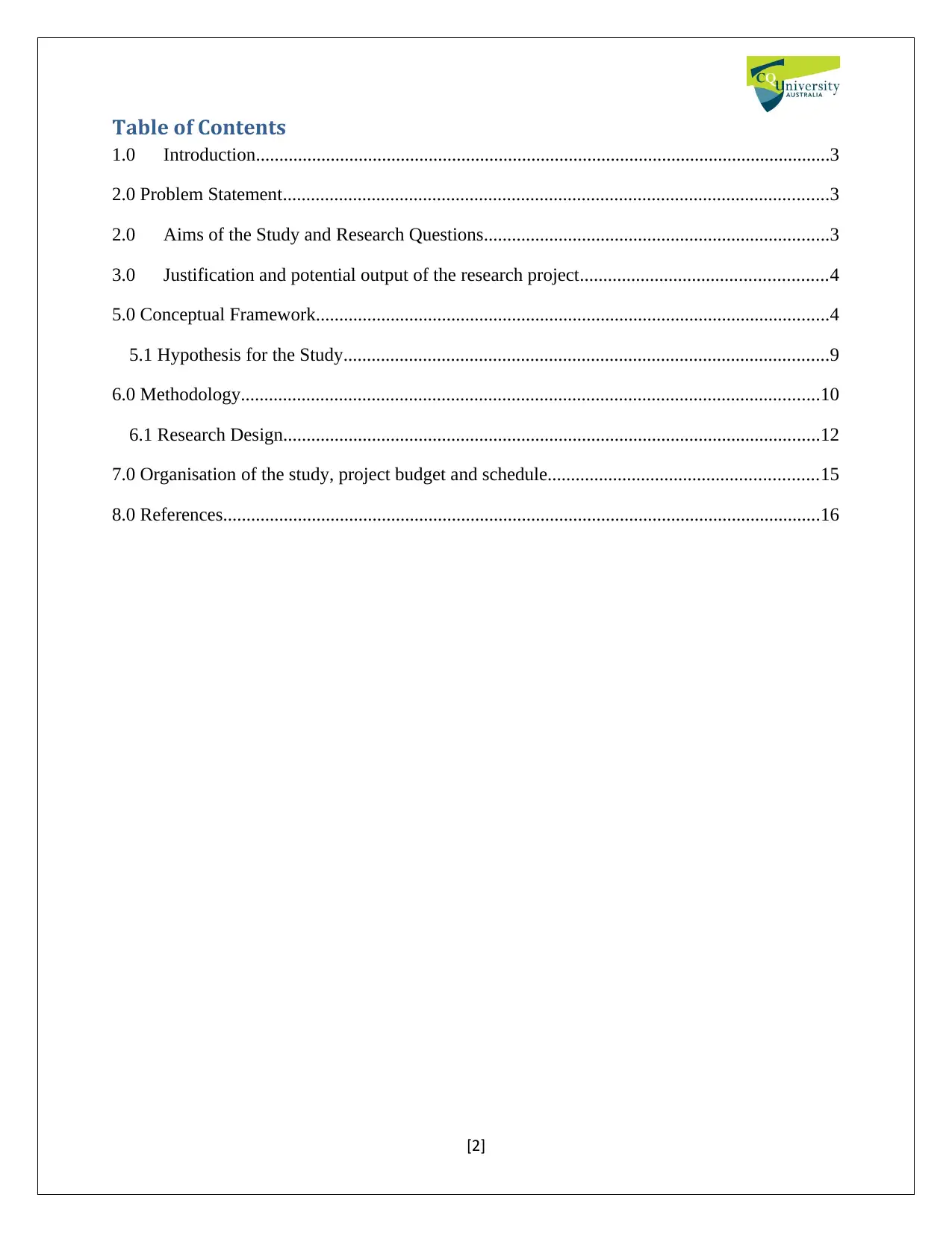
Table of Contents
1.0 Introduction...........................................................................................................................3
2.0 Problem Statement.....................................................................................................................3
2.0 Aims of the Study and Research Questions..........................................................................3
3.0 Justification and potential output of the research project.....................................................4
5.0 Conceptual Framework..............................................................................................................4
5.1 Hypothesis for the Study........................................................................................................9
6.0 Methodology............................................................................................................................10
6.1 Research Design...................................................................................................................12
7.0 Organisation of the study, project budget and schedule..........................................................15
8.0 References................................................................................................................................16
[2]
1.0 Introduction...........................................................................................................................3
2.0 Problem Statement.....................................................................................................................3
2.0 Aims of the Study and Research Questions..........................................................................3
3.0 Justification and potential output of the research project.....................................................4
5.0 Conceptual Framework..............................................................................................................4
5.1 Hypothesis for the Study........................................................................................................9
6.0 Methodology............................................................................................................................10
6.1 Research Design...................................................................................................................12
7.0 Organisation of the study, project budget and schedule..........................................................15
8.0 References................................................................................................................................16
[2]
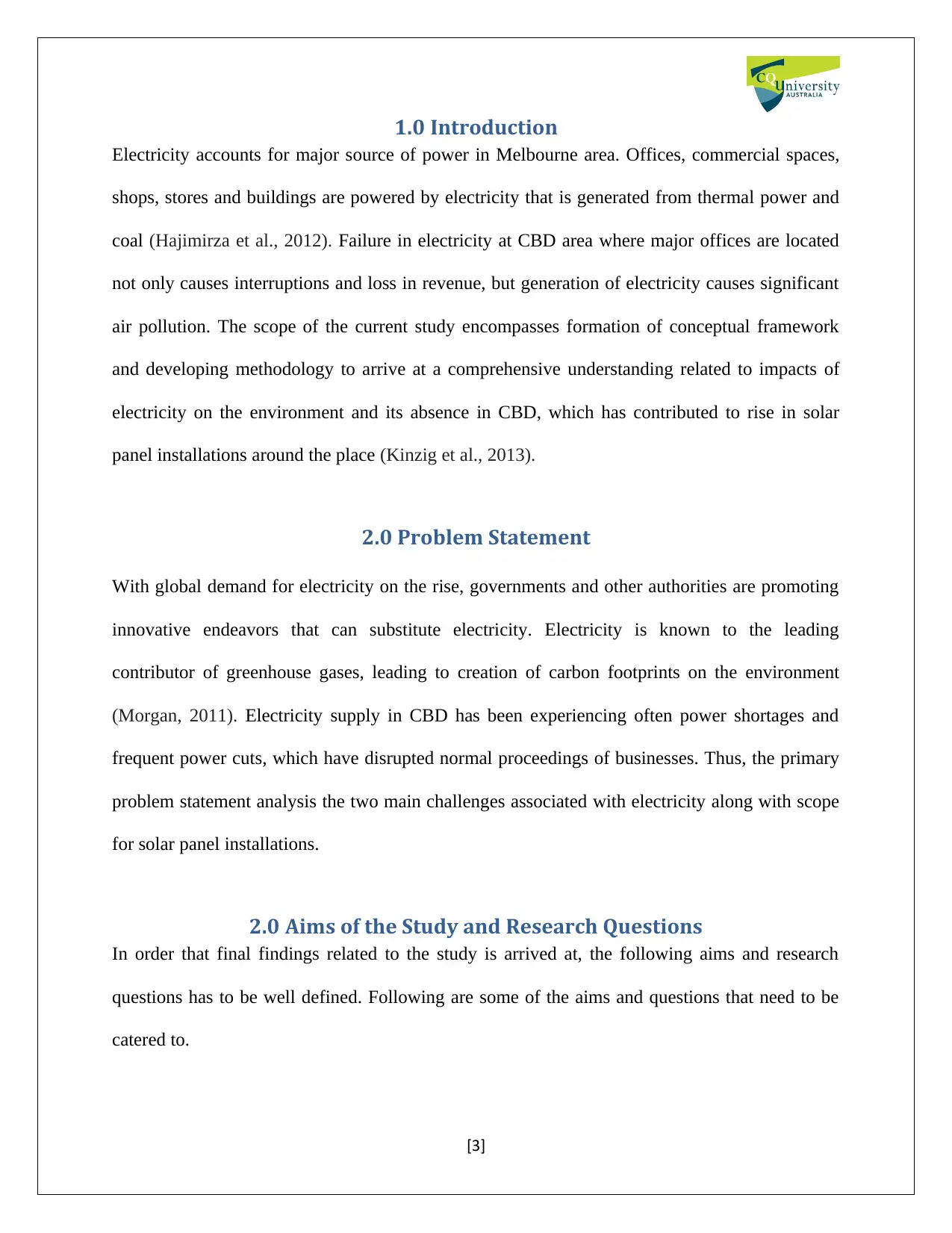
1.0 Introduction
Electricity accounts for major source of power in Melbourne area. Offices, commercial spaces,
shops, stores and buildings are powered by electricity that is generated from thermal power and
coal (Hajimirza et al., 2012). Failure in electricity at CBD area where major offices are located
not only causes interruptions and loss in revenue, but generation of electricity causes significant
air pollution. The scope of the current study encompasses formation of conceptual framework
and developing methodology to arrive at a comprehensive understanding related to impacts of
electricity on the environment and its absence in CBD, which has contributed to rise in solar
panel installations around the place (Kinzig et al., 2013).
2.0 Problem Statement
With global demand for electricity on the rise, governments and other authorities are promoting
innovative endeavors that can substitute electricity. Electricity is known to the leading
contributor of greenhouse gases, leading to creation of carbon footprints on the environment
(Morgan, 2011). Electricity supply in CBD has been experiencing often power shortages and
frequent power cuts, which have disrupted normal proceedings of businesses. Thus, the primary
problem statement analysis the two main challenges associated with electricity along with scope
for solar panel installations.
2.0 Aims of the Study and Research Questions
In order that final findings related to the study is arrived at, the following aims and research
questions has to be well defined. Following are some of the aims and questions that need to be
catered to.
[3]
Electricity accounts for major source of power in Melbourne area. Offices, commercial spaces,
shops, stores and buildings are powered by electricity that is generated from thermal power and
coal (Hajimirza et al., 2012). Failure in electricity at CBD area where major offices are located
not only causes interruptions and loss in revenue, but generation of electricity causes significant
air pollution. The scope of the current study encompasses formation of conceptual framework
and developing methodology to arrive at a comprehensive understanding related to impacts of
electricity on the environment and its absence in CBD, which has contributed to rise in solar
panel installations around the place (Kinzig et al., 2013).
2.0 Problem Statement
With global demand for electricity on the rise, governments and other authorities are promoting
innovative endeavors that can substitute electricity. Electricity is known to the leading
contributor of greenhouse gases, leading to creation of carbon footprints on the environment
(Morgan, 2011). Electricity supply in CBD has been experiencing often power shortages and
frequent power cuts, which have disrupted normal proceedings of businesses. Thus, the primary
problem statement analysis the two main challenges associated with electricity along with scope
for solar panel installations.
2.0 Aims of the Study and Research Questions
In order that final findings related to the study is arrived at, the following aims and research
questions has to be well defined. Following are some of the aims and questions that need to be
catered to.
[3]
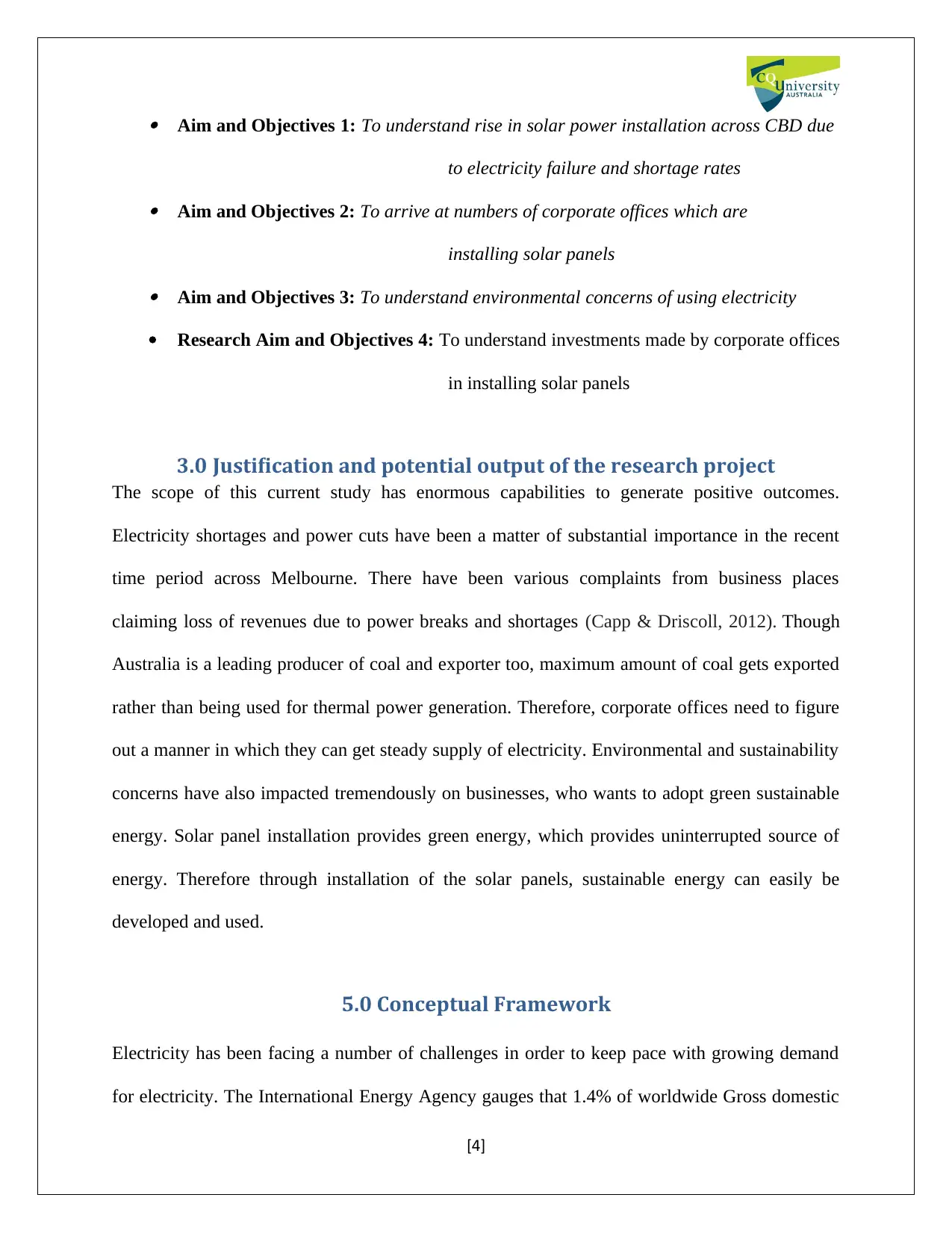
Aim and Objectives 1: To understand rise in solar power installation across CBD due
to electricity failure and shortage rates Aim and Objectives 2: To arrive at numbers of corporate offices which are
installing solar panels Aim and Objectives 3: To understand environmental concerns of using electricity
Research Aim and Objectives 4: To understand investments made by corporate offices
in installing solar panels
3.0 Justification and potential output of the research project
The scope of this current study has enormous capabilities to generate positive outcomes.
Electricity shortages and power cuts have been a matter of substantial importance in the recent
time period across Melbourne. There have been various complaints from business places
claiming loss of revenues due to power breaks and shortages (Capp & Driscoll, 2012). Though
Australia is a leading producer of coal and exporter too, maximum amount of coal gets exported
rather than being used for thermal power generation. Therefore, corporate offices need to figure
out a manner in which they can get steady supply of electricity. Environmental and sustainability
concerns have also impacted tremendously on businesses, who wants to adopt green sustainable
energy. Solar panel installation provides green energy, which provides uninterrupted source of
energy. Therefore through installation of the solar panels, sustainable energy can easily be
developed and used.
5.0 Conceptual Framework
Electricity has been facing a number of challenges in order to keep pace with growing demand
for electricity. The International Energy Agency gauges that 1.4% of worldwide Gross domestic
[4]
to electricity failure and shortage rates Aim and Objectives 2: To arrive at numbers of corporate offices which are
installing solar panels Aim and Objectives 3: To understand environmental concerns of using electricity
Research Aim and Objectives 4: To understand investments made by corporate offices
in installing solar panels
3.0 Justification and potential output of the research project
The scope of this current study has enormous capabilities to generate positive outcomes.
Electricity shortages and power cuts have been a matter of substantial importance in the recent
time period across Melbourne. There have been various complaints from business places
claiming loss of revenues due to power breaks and shortages (Capp & Driscoll, 2012). Though
Australia is a leading producer of coal and exporter too, maximum amount of coal gets exported
rather than being used for thermal power generation. Therefore, corporate offices need to figure
out a manner in which they can get steady supply of electricity. Environmental and sustainability
concerns have also impacted tremendously on businesses, who wants to adopt green sustainable
energy. Solar panel installation provides green energy, which provides uninterrupted source of
energy. Therefore through installation of the solar panels, sustainable energy can easily be
developed and used.
5.0 Conceptual Framework
Electricity has been facing a number of challenges in order to keep pace with growing demand
for electricity. The International Energy Agency gauges that 1.4% of worldwide Gross domestic
[4]
Secure Best Marks with AI Grader
Need help grading? Try our AI Grader for instant feedback on your assignments.
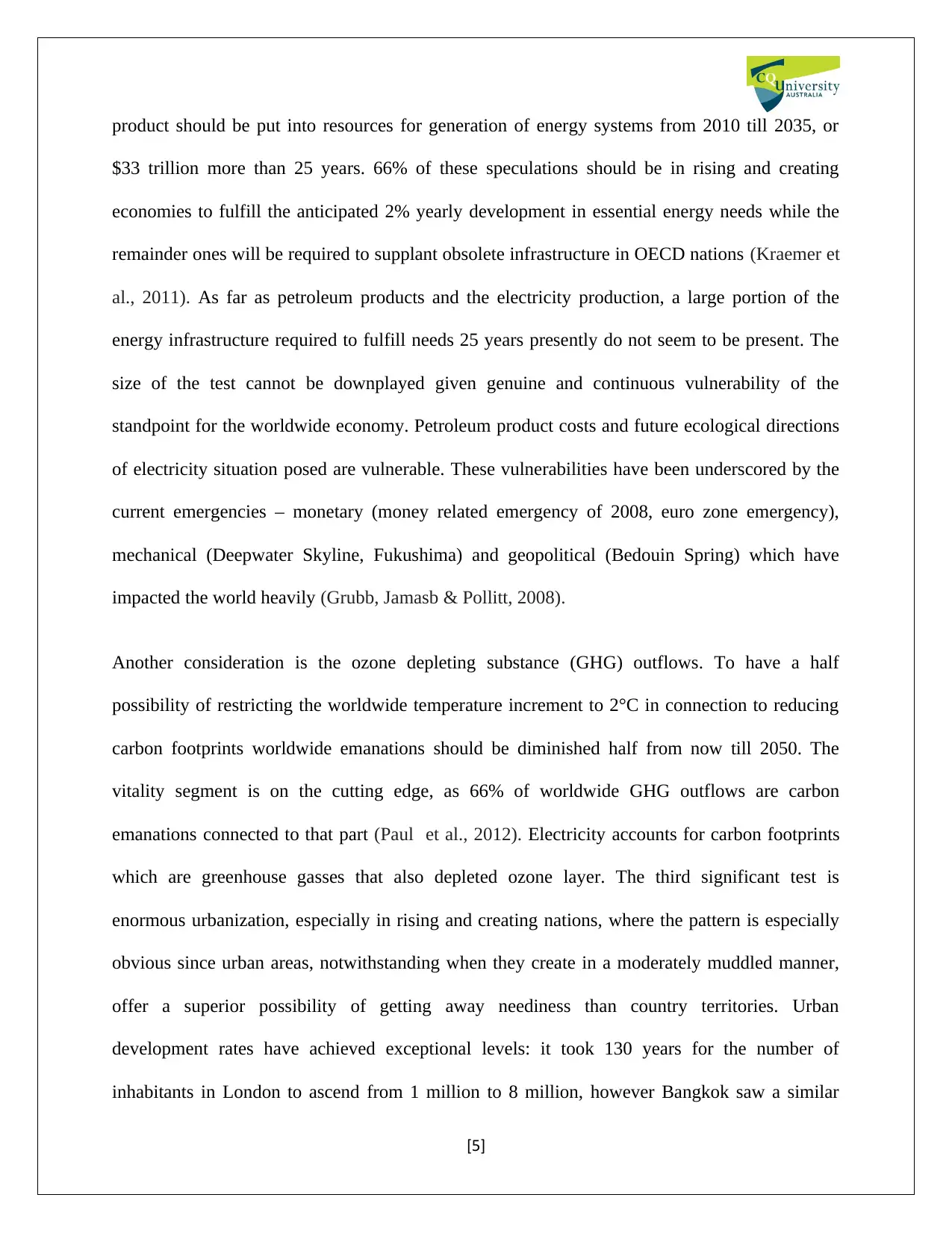
product should be put into resources for generation of energy systems from 2010 till 2035, or
$33 trillion more than 25 years. 66% of these speculations should be in rising and creating
economies to fulfill the anticipated 2% yearly development in essential energy needs while the
remainder ones will be required to supplant obsolete infrastructure in OECD nations (Kraemer et
al., 2011). As far as petroleum products and the electricity production, a large portion of the
energy infrastructure required to fulfill needs 25 years presently do not seem to be present. The
size of the test cannot be downplayed given genuine and continuous vulnerability of the
standpoint for the worldwide economy. Petroleum product costs and future ecological directions
of electricity situation posed are vulnerable. These vulnerabilities have been underscored by the
current emergencies – monetary (money related emergency of 2008, euro zone emergency),
mechanical (Deepwater Skyline, Fukushima) and geopolitical (Bedouin Spring) which have
impacted the world heavily (Grubb, Jamasb & Pollitt, 2008).
Another consideration is the ozone depleting substance (GHG) outflows. To have a half
possibility of restricting the worldwide temperature increment to 2°C in connection to reducing
carbon footprints worldwide emanations should be diminished half from now till 2050. The
vitality segment is on the cutting edge, as 66% of worldwide GHG outflows are carbon
emanations connected to that part (Paul et al., 2012). Electricity accounts for carbon footprints
which are greenhouse gasses that also depleted ozone layer. The third significant test is
enormous urbanization, especially in rising and creating nations, where the pattern is especially
obvious since urban areas, notwithstanding when they create in a moderately muddled manner,
offer a superior possibility of getting away neediness than country territories. Urban
development rates have achieved exceptional levels: it took 130 years for the number of
inhabitants in London to ascend from 1 million to 8 million, however Bangkok saw a similar
[5]
$33 trillion more than 25 years. 66% of these speculations should be in rising and creating
economies to fulfill the anticipated 2% yearly development in essential energy needs while the
remainder ones will be required to supplant obsolete infrastructure in OECD nations (Kraemer et
al., 2011). As far as petroleum products and the electricity production, a large portion of the
energy infrastructure required to fulfill needs 25 years presently do not seem to be present. The
size of the test cannot be downplayed given genuine and continuous vulnerability of the
standpoint for the worldwide economy. Petroleum product costs and future ecological directions
of electricity situation posed are vulnerable. These vulnerabilities have been underscored by the
current emergencies – monetary (money related emergency of 2008, euro zone emergency),
mechanical (Deepwater Skyline, Fukushima) and geopolitical (Bedouin Spring) which have
impacted the world heavily (Grubb, Jamasb & Pollitt, 2008).
Another consideration is the ozone depleting substance (GHG) outflows. To have a half
possibility of restricting the worldwide temperature increment to 2°C in connection to reducing
carbon footprints worldwide emanations should be diminished half from now till 2050. The
vitality segment is on the cutting edge, as 66% of worldwide GHG outflows are carbon
emanations connected to that part (Paul et al., 2012). Electricity accounts for carbon footprints
which are greenhouse gasses that also depleted ozone layer. The third significant test is
enormous urbanization, especially in rising and creating nations, where the pattern is especially
obvious since urban areas, notwithstanding when they create in a moderately muddled manner,
offer a superior possibility of getting away neediness than country territories. Urban
development rates have achieved exceptional levels: it took 130 years for the number of
inhabitants in London to ascend from 1 million to 8 million, however Bangkok saw a similar
[5]
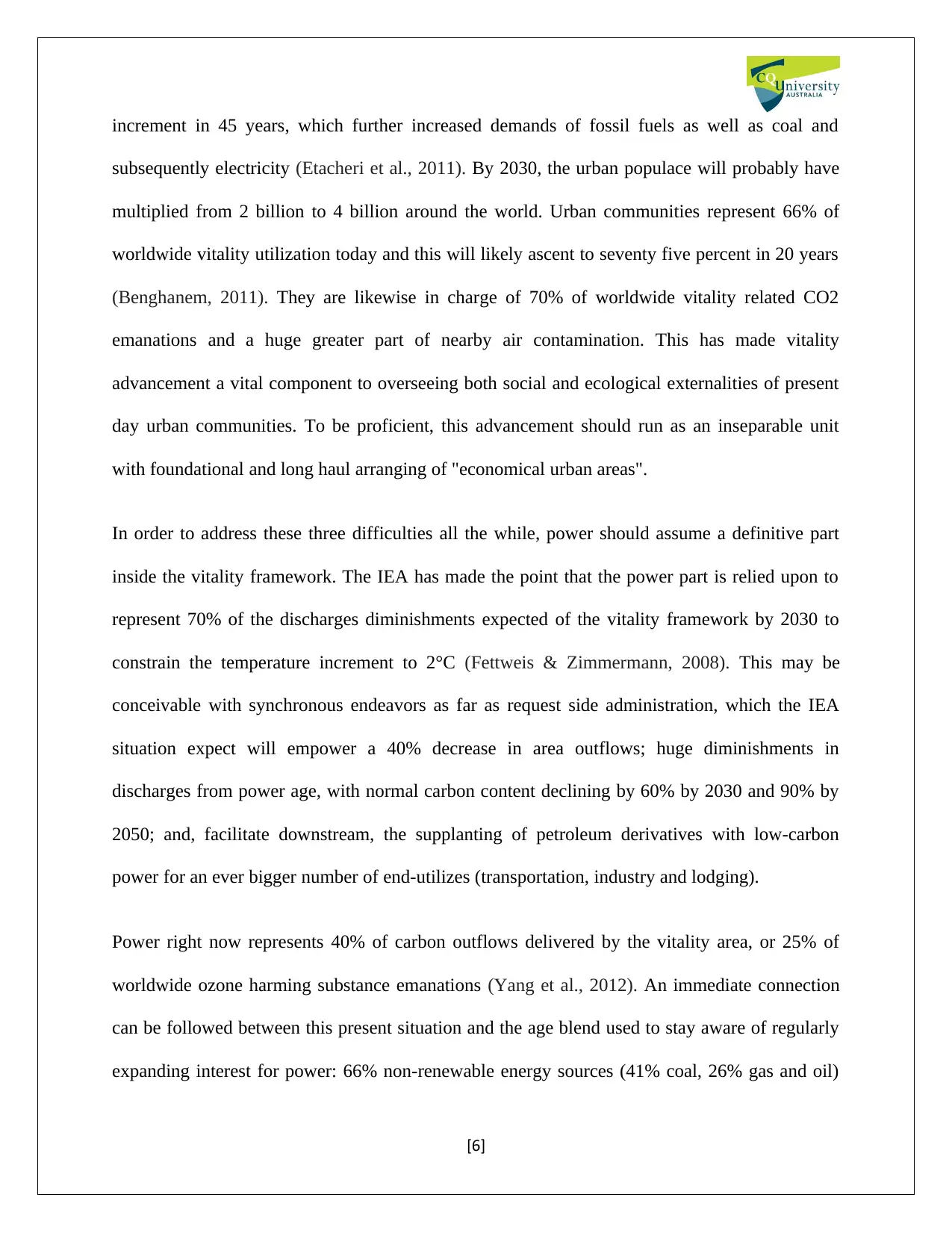
increment in 45 years, which further increased demands of fossil fuels as well as coal and
subsequently electricity (Etacheri et al., 2011). By 2030, the urban populace will probably have
multiplied from 2 billion to 4 billion around the world. Urban communities represent 66% of
worldwide vitality utilization today and this will likely ascent to seventy five percent in 20 years
(Benghanem, 2011). They are likewise in charge of 70% of worldwide vitality related CO2
emanations and a huge greater part of nearby air contamination. This has made vitality
advancement a vital component to overseeing both social and ecological externalities of present
day urban communities. To be proficient, this advancement should run as an inseparable unit
with foundational and long haul arranging of "economical urban areas".
In order to address these three difficulties all the while, power should assume a definitive part
inside the vitality framework. The IEA has made the point that the power part is relied upon to
represent 70% of the discharges diminishments expected of the vitality framework by 2030 to
constrain the temperature increment to 2°C (Fettweis & Zimmermann, 2008). This may be
conceivable with synchronous endeavors as far as request side administration, which the IEA
situation expect will empower a 40% decrease in area outflows; huge diminishments in
discharges from power age, with normal carbon content declining by 60% by 2030 and 90% by
2050; and, facilitate downstream, the supplanting of petroleum derivatives with low-carbon
power for an ever bigger number of end-utilizes (transportation, industry and lodging).
Power right now represents 40% of carbon outflows delivered by the vitality area, or 25% of
worldwide ozone harming substance emanations (Yang et al., 2012). An immediate connection
can be followed between this present situation and the age blend used to stay aware of regularly
expanding interest for power: 66% non-renewable energy sources (41% coal, 26% gas and oil)
[6]
subsequently electricity (Etacheri et al., 2011). By 2030, the urban populace will probably have
multiplied from 2 billion to 4 billion around the world. Urban communities represent 66% of
worldwide vitality utilization today and this will likely ascent to seventy five percent in 20 years
(Benghanem, 2011). They are likewise in charge of 70% of worldwide vitality related CO2
emanations and a huge greater part of nearby air contamination. This has made vitality
advancement a vital component to overseeing both social and ecological externalities of present
day urban communities. To be proficient, this advancement should run as an inseparable unit
with foundational and long haul arranging of "economical urban areas".
In order to address these three difficulties all the while, power should assume a definitive part
inside the vitality framework. The IEA has made the point that the power part is relied upon to
represent 70% of the discharges diminishments expected of the vitality framework by 2030 to
constrain the temperature increment to 2°C (Fettweis & Zimmermann, 2008). This may be
conceivable with synchronous endeavors as far as request side administration, which the IEA
situation expect will empower a 40% decrease in area outflows; huge diminishments in
discharges from power age, with normal carbon content declining by 60% by 2030 and 90% by
2050; and, facilitate downstream, the supplanting of petroleum derivatives with low-carbon
power for an ever bigger number of end-utilizes (transportation, industry and lodging).
Power right now represents 40% of carbon outflows delivered by the vitality area, or 25% of
worldwide ozone harming substance emanations (Yang et al., 2012). An immediate connection
can be followed between this present situation and the age blend used to stay aware of regularly
expanding interest for power: 66% non-renewable energy sources (41% coal, 26% gas and oil)
[6]
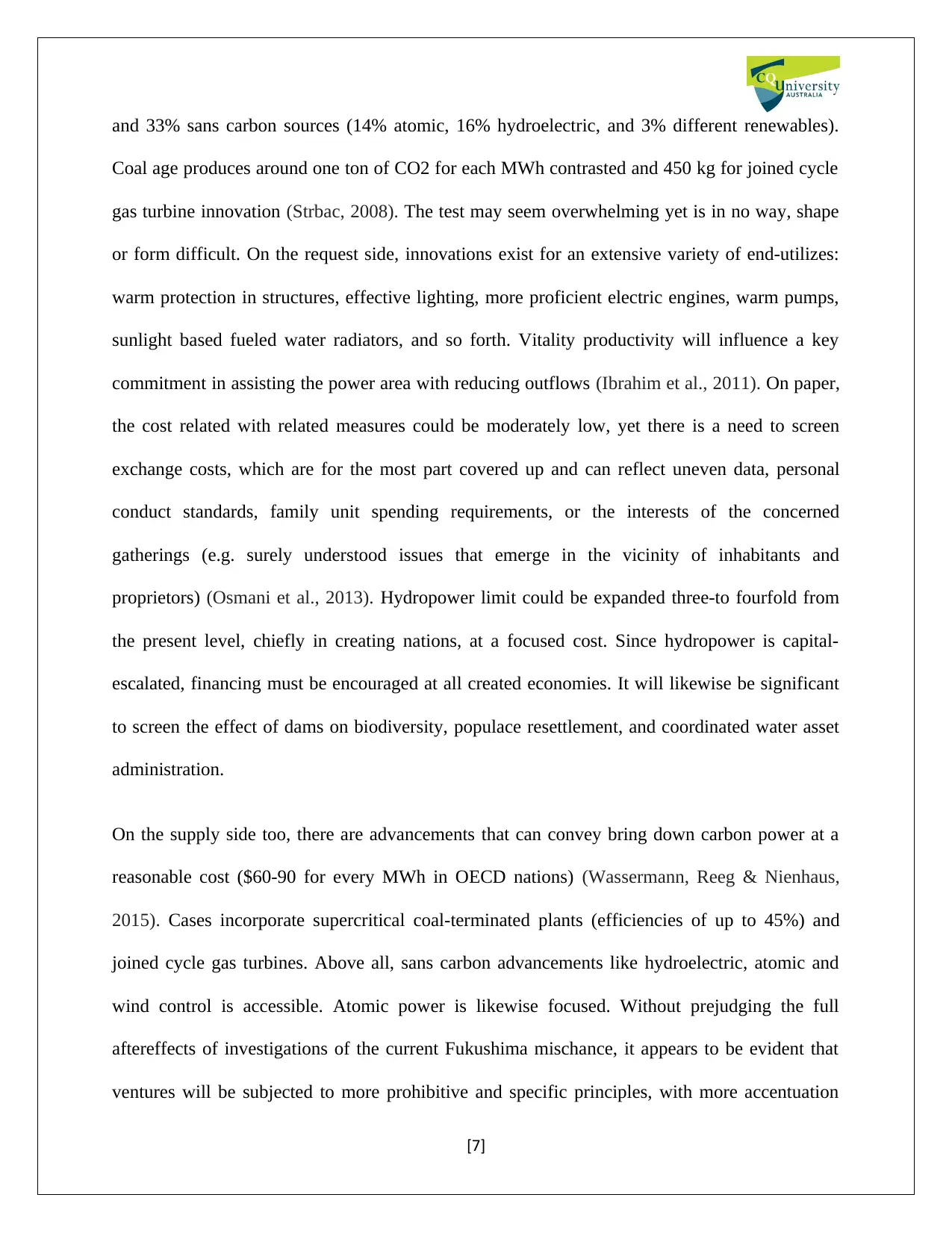
and 33% sans carbon sources (14% atomic, 16% hydroelectric, and 3% different renewables).
Coal age produces around one ton of CO2 for each MWh contrasted and 450 kg for joined cycle
gas turbine innovation (Strbac, 2008). The test may seem overwhelming yet is in no way, shape
or form difficult. On the request side, innovations exist for an extensive variety of end-utilizes:
warm protection in structures, effective lighting, more proficient electric engines, warm pumps,
sunlight based fueled water radiators, and so forth. Vitality productivity will influence a key
commitment in assisting the power area with reducing outflows (Ibrahim et al., 2011). On paper,
the cost related with related measures could be moderately low, yet there is a need to screen
exchange costs, which are for the most part covered up and can reflect uneven data, personal
conduct standards, family unit spending requirements, or the interests of the concerned
gatherings (e.g. surely understood issues that emerge in the vicinity of inhabitants and
proprietors) (Osmani et al., 2013). Hydropower limit could be expanded three-to fourfold from
the present level, chiefly in creating nations, at a focused cost. Since hydropower is capital-
escalated, financing must be encouraged at all created economies. It will likewise be significant
to screen the effect of dams on biodiversity, populace resettlement, and coordinated water asset
administration.
On the supply side too, there are advancements that can convey bring down carbon power at a
reasonable cost ($60-90 for every MWh in OECD nations) (Wassermann, Reeg & Nienhaus,
2015). Cases incorporate supercritical coal-terminated plants (efficiencies of up to 45%) and
joined cycle gas turbines. Above all, sans carbon advancements like hydroelectric, atomic and
wind control is accessible. Atomic power is likewise focused. Without prejudging the full
aftereffects of investigations of the current Fukushima mischance, it appears to be evident that
ventures will be subjected to more prohibitive and specific principles, with more accentuation
[7]
Coal age produces around one ton of CO2 for each MWh contrasted and 450 kg for joined cycle
gas turbine innovation (Strbac, 2008). The test may seem overwhelming yet is in no way, shape
or form difficult. On the request side, innovations exist for an extensive variety of end-utilizes:
warm protection in structures, effective lighting, more proficient electric engines, warm pumps,
sunlight based fueled water radiators, and so forth. Vitality productivity will influence a key
commitment in assisting the power area with reducing outflows (Ibrahim et al., 2011). On paper,
the cost related with related measures could be moderately low, yet there is a need to screen
exchange costs, which are for the most part covered up and can reflect uneven data, personal
conduct standards, family unit spending requirements, or the interests of the concerned
gatherings (e.g. surely understood issues that emerge in the vicinity of inhabitants and
proprietors) (Osmani et al., 2013). Hydropower limit could be expanded three-to fourfold from
the present level, chiefly in creating nations, at a focused cost. Since hydropower is capital-
escalated, financing must be encouraged at all created economies. It will likewise be significant
to screen the effect of dams on biodiversity, populace resettlement, and coordinated water asset
administration.
On the supply side too, there are advancements that can convey bring down carbon power at a
reasonable cost ($60-90 for every MWh in OECD nations) (Wassermann, Reeg & Nienhaus,
2015). Cases incorporate supercritical coal-terminated plants (efficiencies of up to 45%) and
joined cycle gas turbines. Above all, sans carbon advancements like hydroelectric, atomic and
wind control is accessible. Atomic power is likewise focused. Without prejudging the full
aftereffects of investigations of the current Fukushima mischance, it appears to be evident that
ventures will be subjected to more prohibitive and specific principles, with more accentuation
[7]
Paraphrase This Document
Need a fresh take? Get an instant paraphrase of this document with our AI Paraphraser
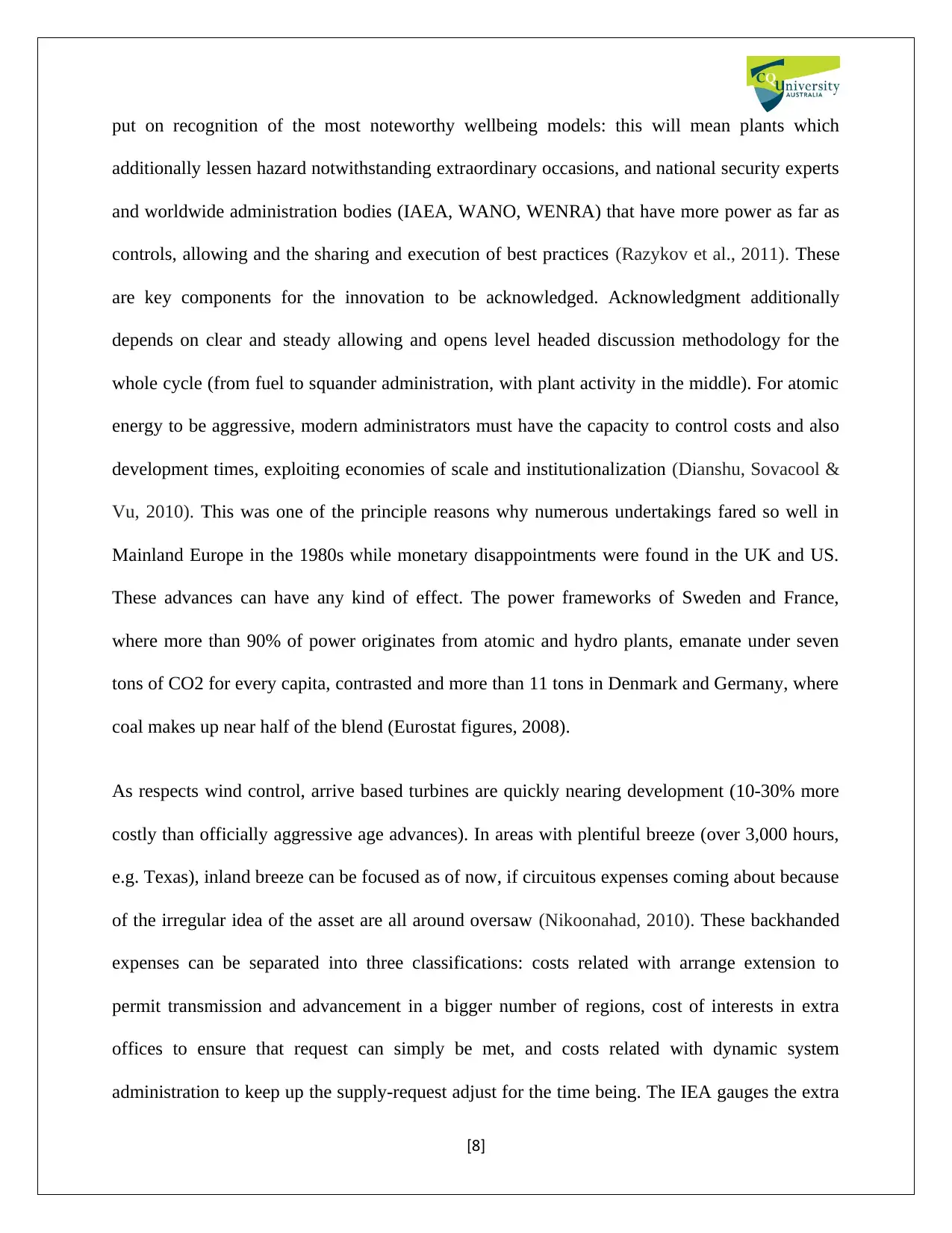
put on recognition of the most noteworthy wellbeing models: this will mean plants which
additionally lessen hazard notwithstanding extraordinary occasions, and national security experts
and worldwide administration bodies (IAEA, WANO, WENRA) that have more power as far as
controls, allowing and the sharing and execution of best practices (Razykov et al., 2011). These
are key components for the innovation to be acknowledged. Acknowledgment additionally
depends on clear and steady allowing and opens level headed discussion methodology for the
whole cycle (from fuel to squander administration, with plant activity in the middle). For atomic
energy to be aggressive, modern administrators must have the capacity to control costs and also
development times, exploiting economies of scale and institutionalization (Dianshu, Sovacool &
Vu, 2010). This was one of the principle reasons why numerous undertakings fared so well in
Mainland Europe in the 1980s while monetary disappointments were found in the UK and US.
These advances can have any kind of effect. The power frameworks of Sweden and France,
where more than 90% of power originates from atomic and hydro plants, emanate under seven
tons of CO2 for every capita, contrasted and more than 11 tons in Denmark and Germany, where
coal makes up near half of the blend (Eurostat figures, 2008).
As respects wind control, arrive based turbines are quickly nearing development (10-30% more
costly than officially aggressive age advances). In areas with plentiful breeze (over 3,000 hours,
e.g. Texas), inland breeze can be focused as of now, if circuitous expenses coming about because
of the irregular idea of the asset are all around oversaw (Nikoonahad, 2010). These backhanded
expenses can be separated into three classifications: costs related with arrange extension to
permit transmission and advancement in a bigger number of regions, cost of interests in extra
offices to ensure that request can simply be met, and costs related with dynamic system
administration to keep up the supply-request adjust for the time being. The IEA gauges the extra
[8]
additionally lessen hazard notwithstanding extraordinary occasions, and national security experts
and worldwide administration bodies (IAEA, WANO, WENRA) that have more power as far as
controls, allowing and the sharing and execution of best practices (Razykov et al., 2011). These
are key components for the innovation to be acknowledged. Acknowledgment additionally
depends on clear and steady allowing and opens level headed discussion methodology for the
whole cycle (from fuel to squander administration, with plant activity in the middle). For atomic
energy to be aggressive, modern administrators must have the capacity to control costs and also
development times, exploiting economies of scale and institutionalization (Dianshu, Sovacool &
Vu, 2010). This was one of the principle reasons why numerous undertakings fared so well in
Mainland Europe in the 1980s while monetary disappointments were found in the UK and US.
These advances can have any kind of effect. The power frameworks of Sweden and France,
where more than 90% of power originates from atomic and hydro plants, emanate under seven
tons of CO2 for every capita, contrasted and more than 11 tons in Denmark and Germany, where
coal makes up near half of the blend (Eurostat figures, 2008).
As respects wind control, arrive based turbines are quickly nearing development (10-30% more
costly than officially aggressive age advances). In areas with plentiful breeze (over 3,000 hours,
e.g. Texas), inland breeze can be focused as of now, if circuitous expenses coming about because
of the irregular idea of the asset are all around oversaw (Nikoonahad, 2010). These backhanded
expenses can be separated into three classifications: costs related with arrange extension to
permit transmission and advancement in a bigger number of regions, cost of interests in extra
offices to ensure that request can simply be met, and costs related with dynamic system
administration to keep up the supply-request adjust for the time being. The IEA gauges the extra
[8]
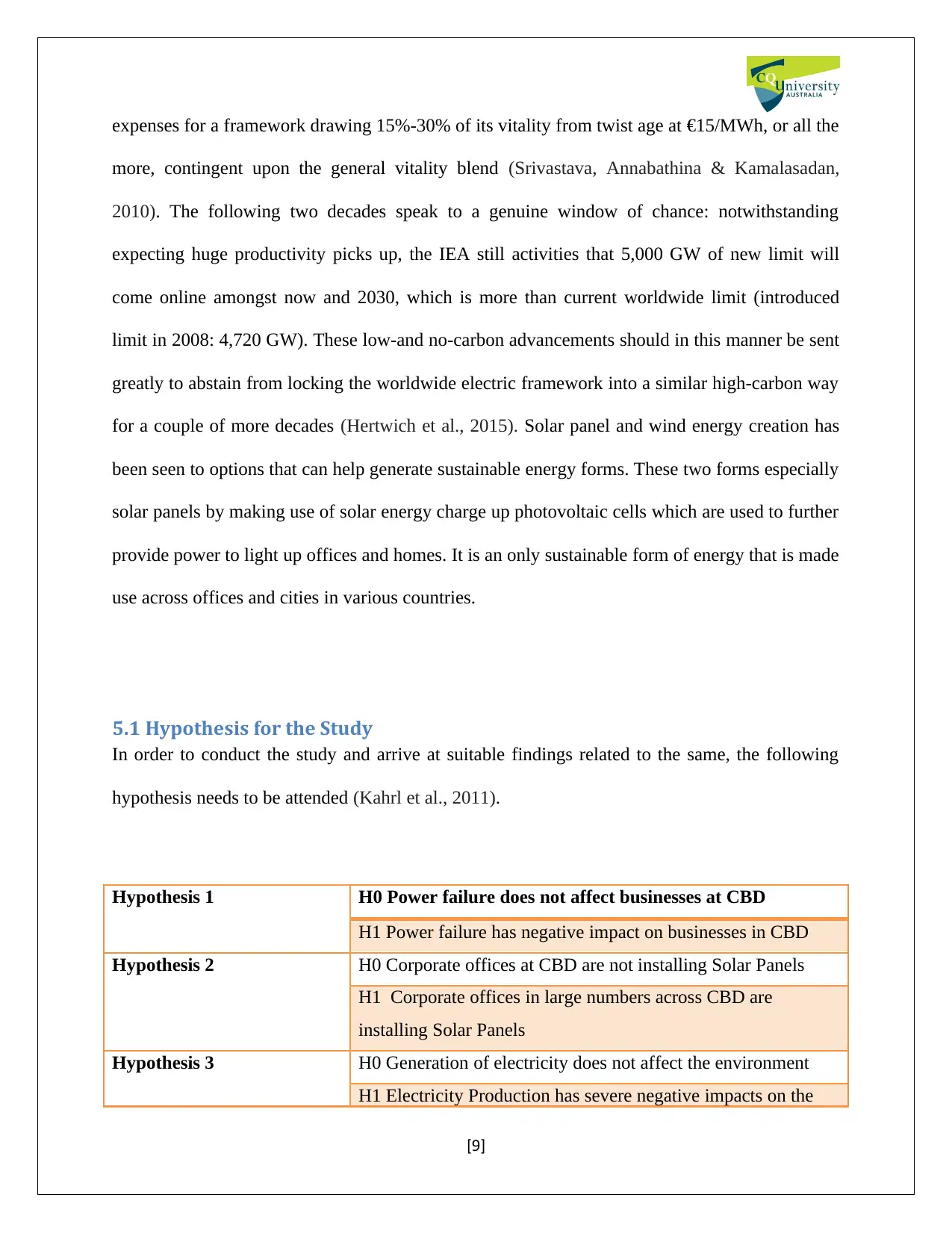
expenses for a framework drawing 15%-30% of its vitality from twist age at €15/MWh, or all the
more, contingent upon the general vitality blend (Srivastava, Annabathina & Kamalasadan,
2010). The following two decades speak to a genuine window of chance: notwithstanding
expecting huge productivity picks up, the IEA still activities that 5,000 GW of new limit will
come online amongst now and 2030, which is more than current worldwide limit (introduced
limit in 2008: 4,720 GW). These low-and no-carbon advancements should in this manner be sent
greatly to abstain from locking the worldwide electric framework into a similar high-carbon way
for a couple of more decades (Hertwich et al., 2015). Solar panel and wind energy creation has
been seen to options that can help generate sustainable energy forms. These two forms especially
solar panels by making use of solar energy charge up photovoltaic cells which are used to further
provide power to light up offices and homes. It is an only sustainable form of energy that is made
use across offices and cities in various countries.
5.1 Hypothesis for the Study
In order to conduct the study and arrive at suitable findings related to the same, the following
hypothesis needs to be attended (Kahrl et al., 2011).
Hypothesis 1 H0 Power failure does not affect businesses at CBD
H1 Power failure has negative impact on businesses in CBD
Hypothesis 2 H0 Corporate offices at CBD are not installing Solar Panels
H1 Corporate offices in large numbers across CBD are
installing Solar Panels
Hypothesis 3 H0 Generation of electricity does not affect the environment
H1 Electricity Production has severe negative impacts on the
[9]
more, contingent upon the general vitality blend (Srivastava, Annabathina & Kamalasadan,
2010). The following two decades speak to a genuine window of chance: notwithstanding
expecting huge productivity picks up, the IEA still activities that 5,000 GW of new limit will
come online amongst now and 2030, which is more than current worldwide limit (introduced
limit in 2008: 4,720 GW). These low-and no-carbon advancements should in this manner be sent
greatly to abstain from locking the worldwide electric framework into a similar high-carbon way
for a couple of more decades (Hertwich et al., 2015). Solar panel and wind energy creation has
been seen to options that can help generate sustainable energy forms. These two forms especially
solar panels by making use of solar energy charge up photovoltaic cells which are used to further
provide power to light up offices and homes. It is an only sustainable form of energy that is made
use across offices and cities in various countries.
5.1 Hypothesis for the Study
In order to conduct the study and arrive at suitable findings related to the same, the following
hypothesis needs to be attended (Kahrl et al., 2011).
Hypothesis 1 H0 Power failure does not affect businesses at CBD
H1 Power failure has negative impact on businesses in CBD
Hypothesis 2 H0 Corporate offices at CBD are not installing Solar Panels
H1 Corporate offices in large numbers across CBD are
installing Solar Panels
Hypothesis 3 H0 Generation of electricity does not affect the environment
H1 Electricity Production has severe negative impacts on the
[9]
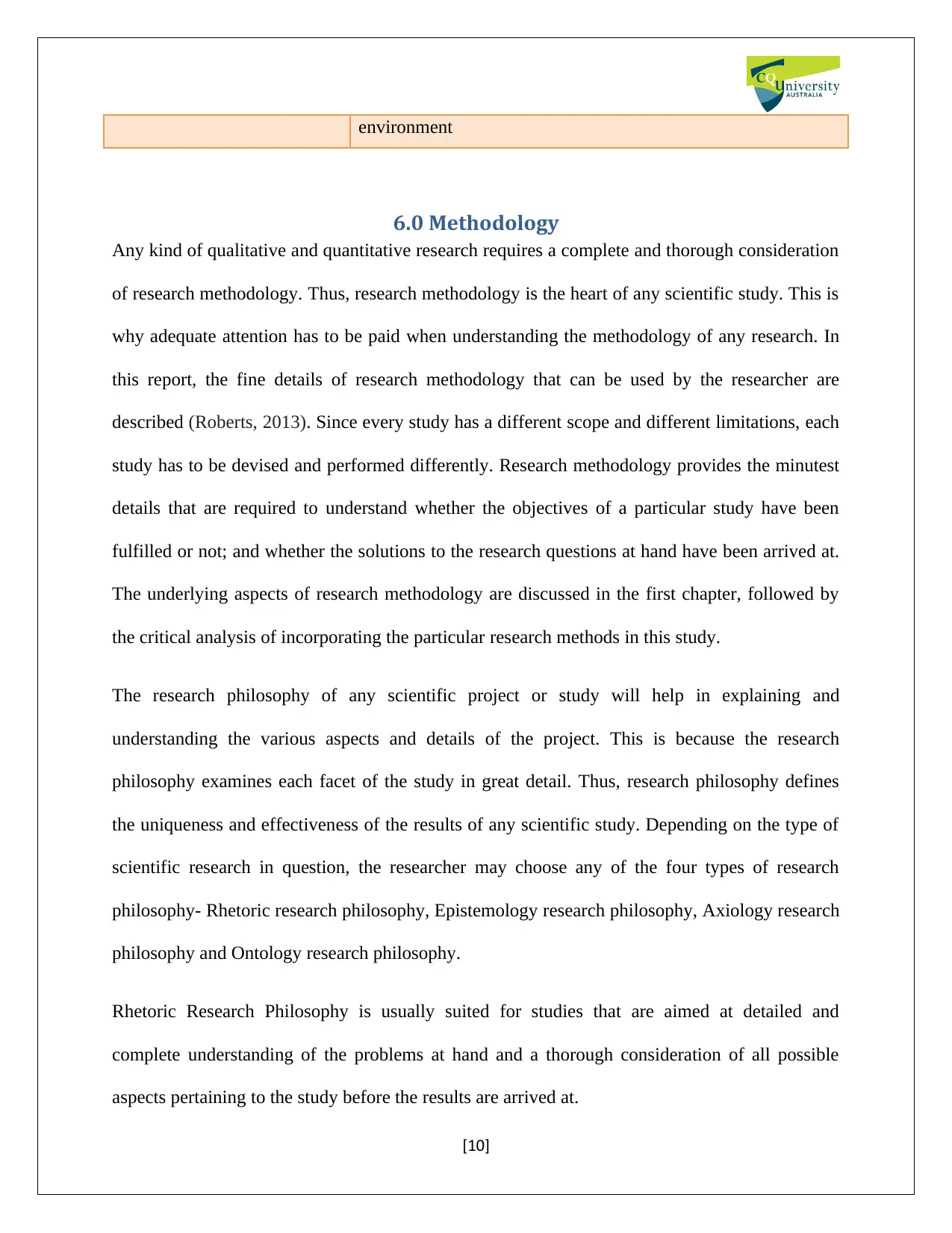
environment
6.0 Methodology
Any kind of qualitative and quantitative research requires a complete and thorough consideration
of research methodology. Thus, research methodology is the heart of any scientific study. This is
why adequate attention has to be paid when understanding the methodology of any research. In
this report, the fine details of research methodology that can be used by the researcher are
described (Roberts, 2013). Since every study has a different scope and different limitations, each
study has to be devised and performed differently. Research methodology provides the minutest
details that are required to understand whether the objectives of a particular study have been
fulfilled or not; and whether the solutions to the research questions at hand have been arrived at.
The underlying aspects of research methodology are discussed in the first chapter, followed by
the critical analysis of incorporating the particular research methods in this study.
The research philosophy of any scientific project or study will help in explaining and
understanding the various aspects and details of the project. This is because the research
philosophy examines each facet of the study in great detail. Thus, research philosophy defines
the uniqueness and effectiveness of the results of any scientific study. Depending on the type of
scientific research in question, the researcher may choose any of the four types of research
philosophy- Rhetoric research philosophy, Epistemology research philosophy, Axiology research
philosophy and Ontology research philosophy.
Rhetoric Research Philosophy is usually suited for studies that are aimed at detailed and
complete understanding of the problems at hand and a thorough consideration of all possible
aspects pertaining to the study before the results are arrived at.
[10]
6.0 Methodology
Any kind of qualitative and quantitative research requires a complete and thorough consideration
of research methodology. Thus, research methodology is the heart of any scientific study. This is
why adequate attention has to be paid when understanding the methodology of any research. In
this report, the fine details of research methodology that can be used by the researcher are
described (Roberts, 2013). Since every study has a different scope and different limitations, each
study has to be devised and performed differently. Research methodology provides the minutest
details that are required to understand whether the objectives of a particular study have been
fulfilled or not; and whether the solutions to the research questions at hand have been arrived at.
The underlying aspects of research methodology are discussed in the first chapter, followed by
the critical analysis of incorporating the particular research methods in this study.
The research philosophy of any scientific project or study will help in explaining and
understanding the various aspects and details of the project. This is because the research
philosophy examines each facet of the study in great detail. Thus, research philosophy defines
the uniqueness and effectiveness of the results of any scientific study. Depending on the type of
scientific research in question, the researcher may choose any of the four types of research
philosophy- Rhetoric research philosophy, Epistemology research philosophy, Axiology research
philosophy and Ontology research philosophy.
Rhetoric Research Philosophy is usually suited for studies that are aimed at detailed and
complete understanding of the problems at hand and a thorough consideration of all possible
aspects pertaining to the study before the results are arrived at.
[10]
Secure Best Marks with AI Grader
Need help grading? Try our AI Grader for instant feedback on your assignments.
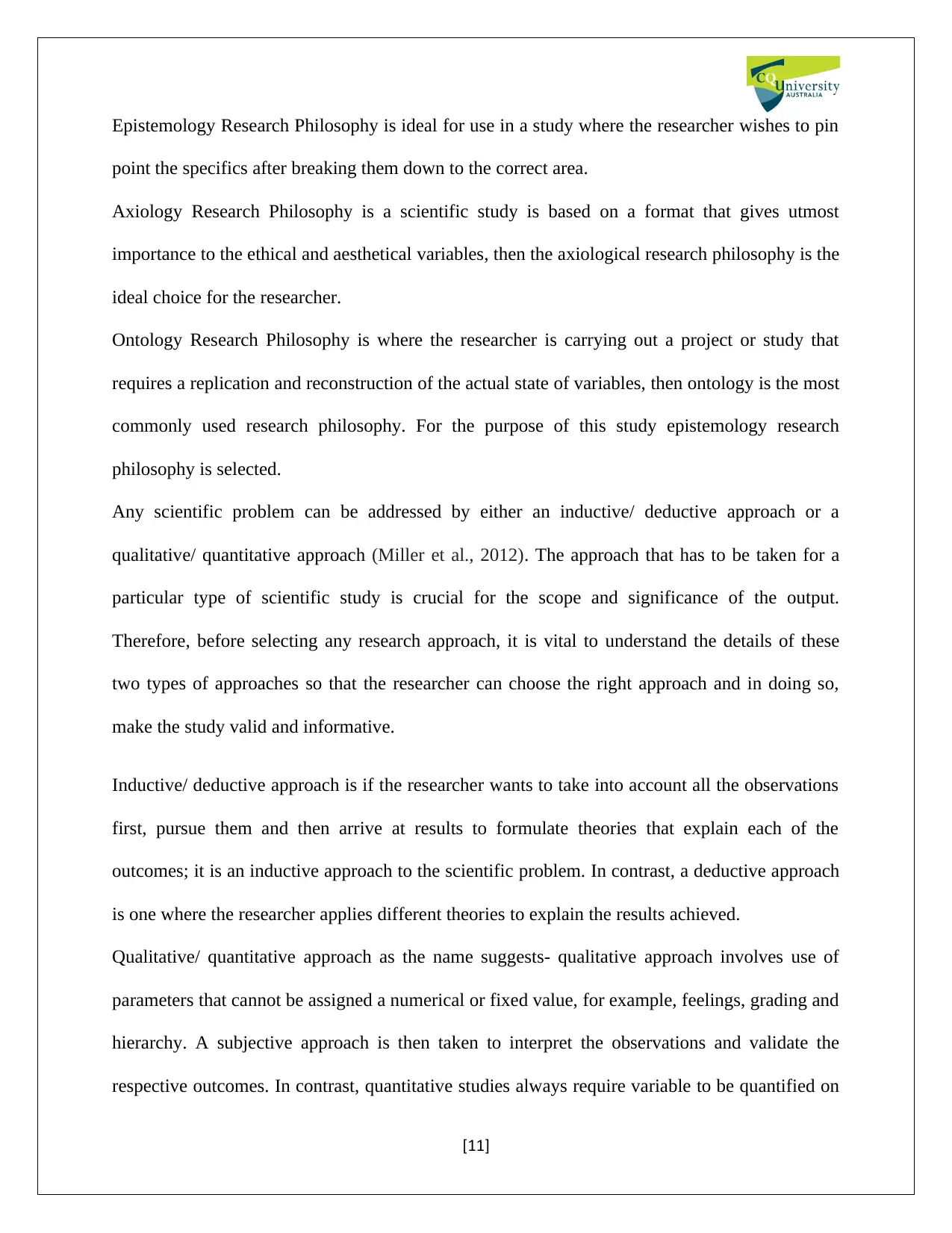
Epistemology Research Philosophy is ideal for use in a study where the researcher wishes to pin
point the specifics after breaking them down to the correct area.
Axiology Research Philosophy is a scientific study is based on a format that gives utmost
importance to the ethical and aesthetical variables, then the axiological research philosophy is the
ideal choice for the researcher.
Ontology Research Philosophy is where the researcher is carrying out a project or study that
requires a replication and reconstruction of the actual state of variables, then ontology is the most
commonly used research philosophy. For the purpose of this study epistemology research
philosophy is selected.
Any scientific problem can be addressed by either an inductive/ deductive approach or a
qualitative/ quantitative approach (Miller et al., 2012). The approach that has to be taken for a
particular type of scientific study is crucial for the scope and significance of the output.
Therefore, before selecting any research approach, it is vital to understand the details of these
two types of approaches so that the researcher can choose the right approach and in doing so,
make the study valid and informative.
Inductive/ deductive approach is if the researcher wants to take into account all the observations
first, pursue them and then arrive at results to formulate theories that explain each of the
outcomes; it is an inductive approach to the scientific problem. In contrast, a deductive approach
is one where the researcher applies different theories to explain the results achieved.
Qualitative/ quantitative approach as the name suggests- qualitative approach involves use of
parameters that cannot be assigned a numerical or fixed value, for example, feelings, grading and
hierarchy. A subjective approach is then taken to interpret the observations and validate the
respective outcomes. In contrast, quantitative studies always require variable to be quantified on
[11]
point the specifics after breaking them down to the correct area.
Axiology Research Philosophy is a scientific study is based on a format that gives utmost
importance to the ethical and aesthetical variables, then the axiological research philosophy is the
ideal choice for the researcher.
Ontology Research Philosophy is where the researcher is carrying out a project or study that
requires a replication and reconstruction of the actual state of variables, then ontology is the most
commonly used research philosophy. For the purpose of this study epistemology research
philosophy is selected.
Any scientific problem can be addressed by either an inductive/ deductive approach or a
qualitative/ quantitative approach (Miller et al., 2012). The approach that has to be taken for a
particular type of scientific study is crucial for the scope and significance of the output.
Therefore, before selecting any research approach, it is vital to understand the details of these
two types of approaches so that the researcher can choose the right approach and in doing so,
make the study valid and informative.
Inductive/ deductive approach is if the researcher wants to take into account all the observations
first, pursue them and then arrive at results to formulate theories that explain each of the
outcomes; it is an inductive approach to the scientific problem. In contrast, a deductive approach
is one where the researcher applies different theories to explain the results achieved.
Qualitative/ quantitative approach as the name suggests- qualitative approach involves use of
parameters that cannot be assigned a numerical or fixed value, for example, feelings, grading and
hierarchy. A subjective approach is then taken to interpret the observations and validate the
respective outcomes. In contrast, quantitative studies always require variable to be quantified on
[11]
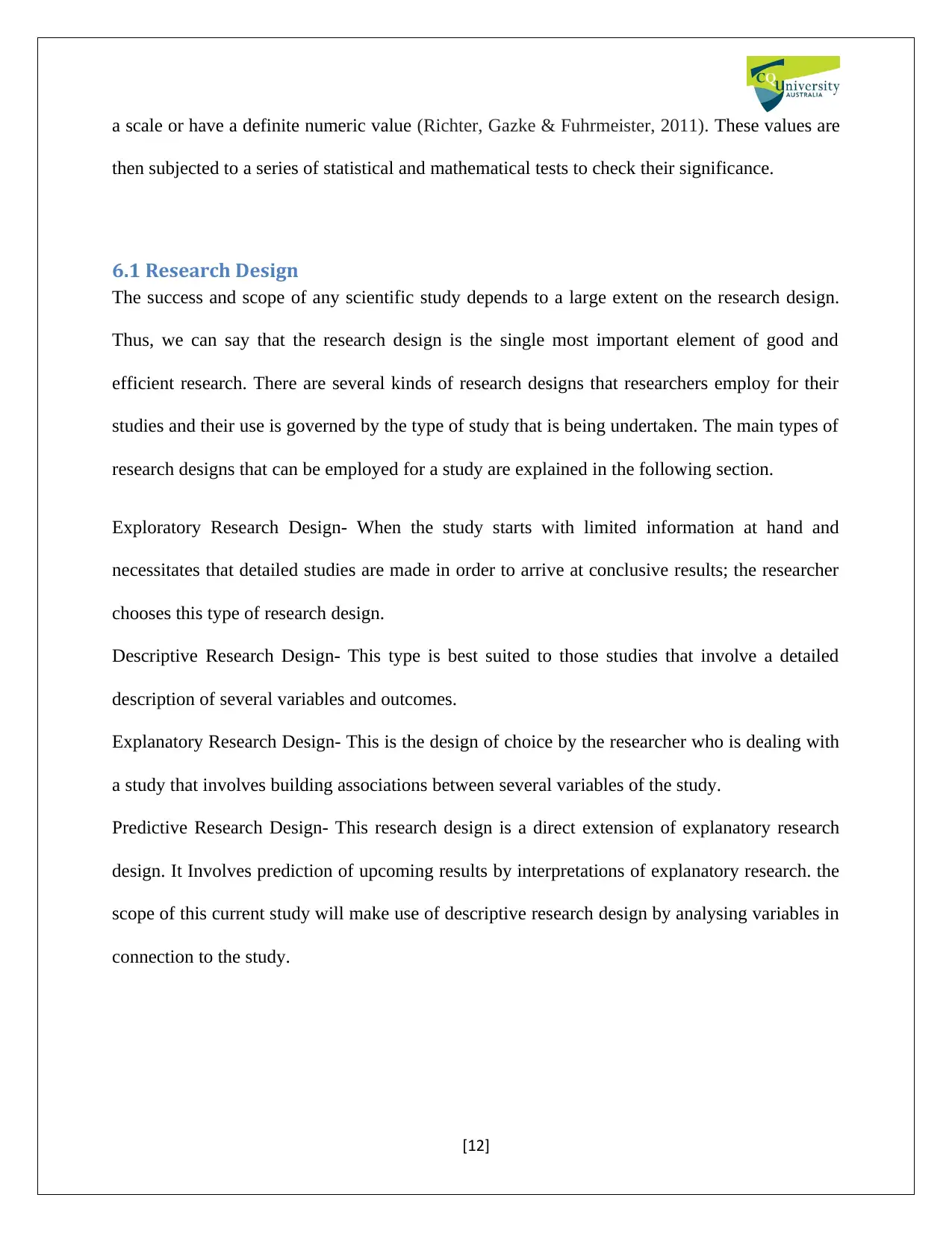
a scale or have a definite numeric value (Richter, Gazke & Fuhrmeister, 2011). These values are
then subjected to a series of statistical and mathematical tests to check their significance.
6.1 Research Design
The success and scope of any scientific study depends to a large extent on the research design.
Thus, we can say that the research design is the single most important element of good and
efficient research. There are several kinds of research designs that researchers employ for their
studies and their use is governed by the type of study that is being undertaken. The main types of
research designs that can be employed for a study are explained in the following section.
Exploratory Research Design- When the study starts with limited information at hand and
necessitates that detailed studies are made in order to arrive at conclusive results; the researcher
chooses this type of research design.
Descriptive Research Design- This type is best suited to those studies that involve a detailed
description of several variables and outcomes.
Explanatory Research Design- This is the design of choice by the researcher who is dealing with
a study that involves building associations between several variables of the study.
Predictive Research Design- This research design is a direct extension of explanatory research
design. It Involves prediction of upcoming results by interpretations of explanatory research. the
scope of this current study will make use of descriptive research design by analysing variables in
connection to the study.
[12]
then subjected to a series of statistical and mathematical tests to check their significance.
6.1 Research Design
The success and scope of any scientific study depends to a large extent on the research design.
Thus, we can say that the research design is the single most important element of good and
efficient research. There are several kinds of research designs that researchers employ for their
studies and their use is governed by the type of study that is being undertaken. The main types of
research designs that can be employed for a study are explained in the following section.
Exploratory Research Design- When the study starts with limited information at hand and
necessitates that detailed studies are made in order to arrive at conclusive results; the researcher
chooses this type of research design.
Descriptive Research Design- This type is best suited to those studies that involve a detailed
description of several variables and outcomes.
Explanatory Research Design- This is the design of choice by the researcher who is dealing with
a study that involves building associations between several variables of the study.
Predictive Research Design- This research design is a direct extension of explanatory research
design. It Involves prediction of upcoming results by interpretations of explanatory research. the
scope of this current study will make use of descriptive research design by analysing variables in
connection to the study.
[12]
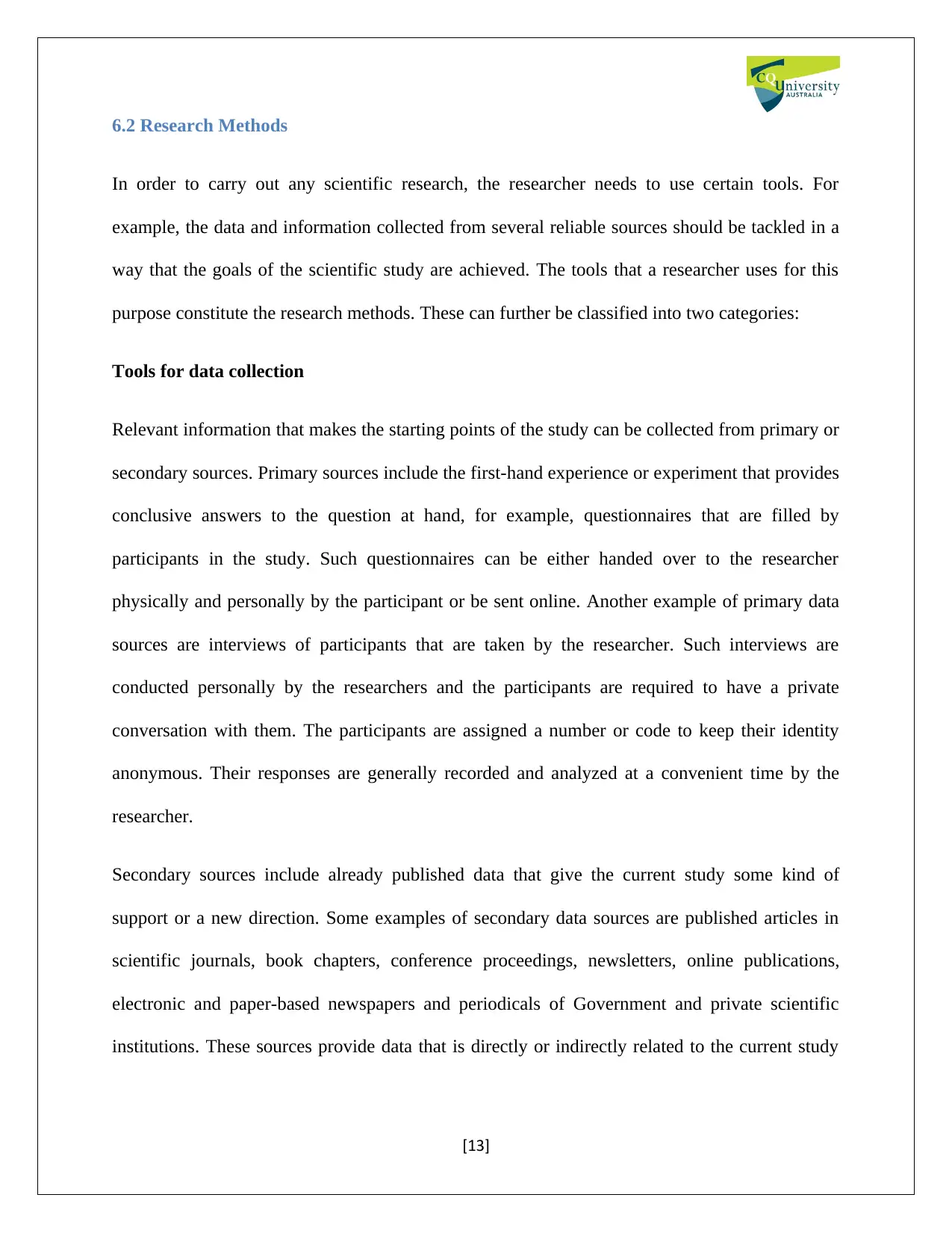
6.2 Research Methods
In order to carry out any scientific research, the researcher needs to use certain tools. For
example, the data and information collected from several reliable sources should be tackled in a
way that the goals of the scientific study are achieved. The tools that a researcher uses for this
purpose constitute the research methods. These can further be classified into two categories:
Tools for data collection
Relevant information that makes the starting points of the study can be collected from primary or
secondary sources. Primary sources include the first-hand experience or experiment that provides
conclusive answers to the question at hand, for example, questionnaires that are filled by
participants in the study. Such questionnaires can be either handed over to the researcher
physically and personally by the participant or be sent online. Another example of primary data
sources are interviews of participants that are taken by the researcher. Such interviews are
conducted personally by the researchers and the participants are required to have a private
conversation with them. The participants are assigned a number or code to keep their identity
anonymous. Their responses are generally recorded and analyzed at a convenient time by the
researcher.
Secondary sources include already published data that give the current study some kind of
support or a new direction. Some examples of secondary data sources are published articles in
scientific journals, book chapters, conference proceedings, newsletters, online publications,
electronic and paper-based newspapers and periodicals of Government and private scientific
institutions. These sources provide data that is directly or indirectly related to the current study
[13]
In order to carry out any scientific research, the researcher needs to use certain tools. For
example, the data and information collected from several reliable sources should be tackled in a
way that the goals of the scientific study are achieved. The tools that a researcher uses for this
purpose constitute the research methods. These can further be classified into two categories:
Tools for data collection
Relevant information that makes the starting points of the study can be collected from primary or
secondary sources. Primary sources include the first-hand experience or experiment that provides
conclusive answers to the question at hand, for example, questionnaires that are filled by
participants in the study. Such questionnaires can be either handed over to the researcher
physically and personally by the participant or be sent online. Another example of primary data
sources are interviews of participants that are taken by the researcher. Such interviews are
conducted personally by the researchers and the participants are required to have a private
conversation with them. The participants are assigned a number or code to keep their identity
anonymous. Their responses are generally recorded and analyzed at a convenient time by the
researcher.
Secondary sources include already published data that give the current study some kind of
support or a new direction. Some examples of secondary data sources are published articles in
scientific journals, book chapters, conference proceedings, newsletters, online publications,
electronic and paper-based newspapers and periodicals of Government and private scientific
institutions. These sources provide data that is directly or indirectly related to the current study
[13]
Paraphrase This Document
Need a fresh take? Get an instant paraphrase of this document with our AI Paraphraser
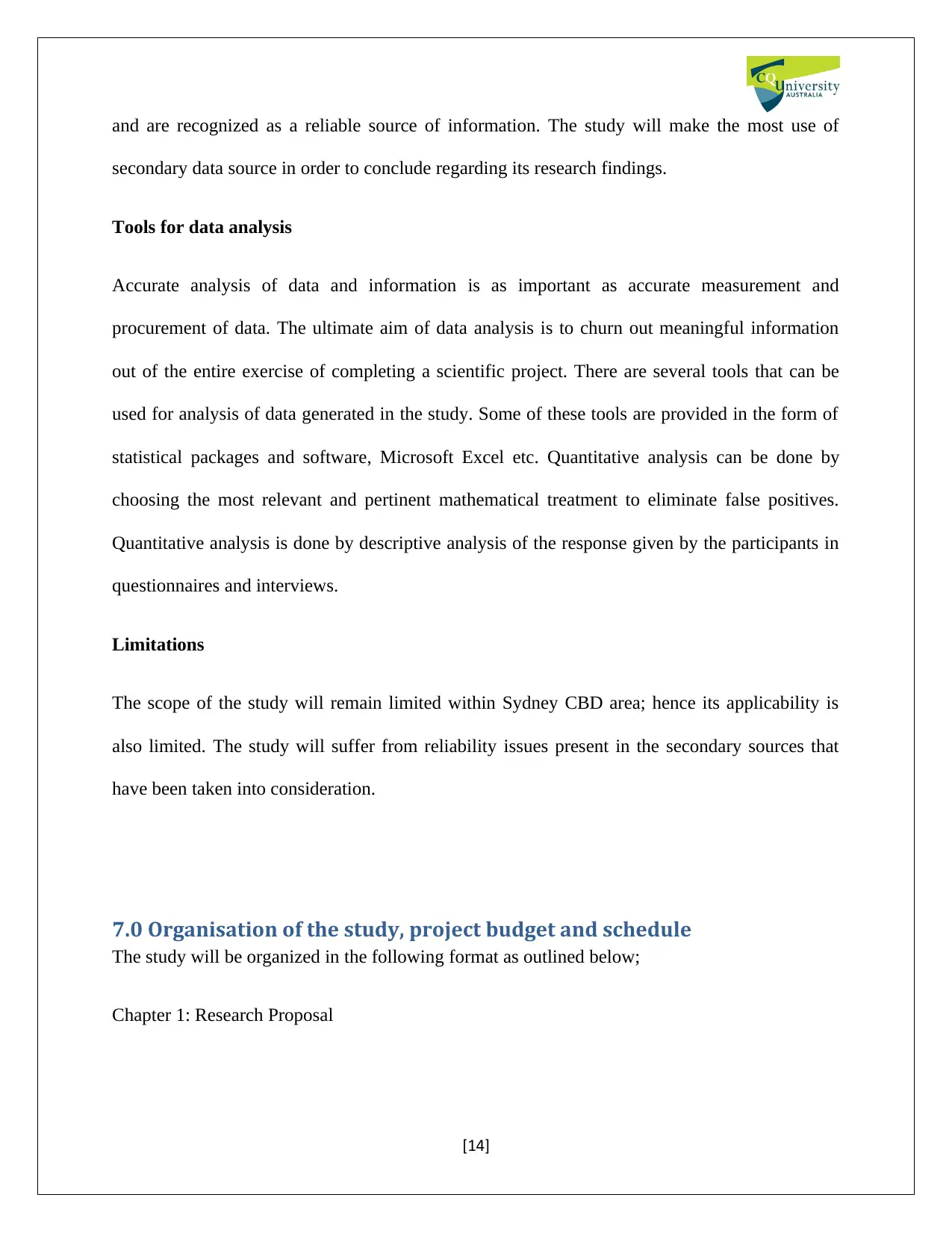
and are recognized as a reliable source of information. The study will make the most use of
secondary data source in order to conclude regarding its research findings.
Tools for data analysis
Accurate analysis of data and information is as important as accurate measurement and
procurement of data. The ultimate aim of data analysis is to churn out meaningful information
out of the entire exercise of completing a scientific project. There are several tools that can be
used for analysis of data generated in the study. Some of these tools are provided in the form of
statistical packages and software, Microsoft Excel etc. Quantitative analysis can be done by
choosing the most relevant and pertinent mathematical treatment to eliminate false positives.
Quantitative analysis is done by descriptive analysis of the response given by the participants in
questionnaires and interviews.
Limitations
The scope of the study will remain limited within Sydney CBD area; hence its applicability is
also limited. The study will suffer from reliability issues present in the secondary sources that
have been taken into consideration.
7.0 Organisation of the study, project budget and schedule
The study will be organized in the following format as outlined below;
Chapter 1: Research Proposal
[14]
secondary data source in order to conclude regarding its research findings.
Tools for data analysis
Accurate analysis of data and information is as important as accurate measurement and
procurement of data. The ultimate aim of data analysis is to churn out meaningful information
out of the entire exercise of completing a scientific project. There are several tools that can be
used for analysis of data generated in the study. Some of these tools are provided in the form of
statistical packages and software, Microsoft Excel etc. Quantitative analysis can be done by
choosing the most relevant and pertinent mathematical treatment to eliminate false positives.
Quantitative analysis is done by descriptive analysis of the response given by the participants in
questionnaires and interviews.
Limitations
The scope of the study will remain limited within Sydney CBD area; hence its applicability is
also limited. The study will suffer from reliability issues present in the secondary sources that
have been taken into consideration.
7.0 Organisation of the study, project budget and schedule
The study will be organized in the following format as outlined below;
Chapter 1: Research Proposal
[14]
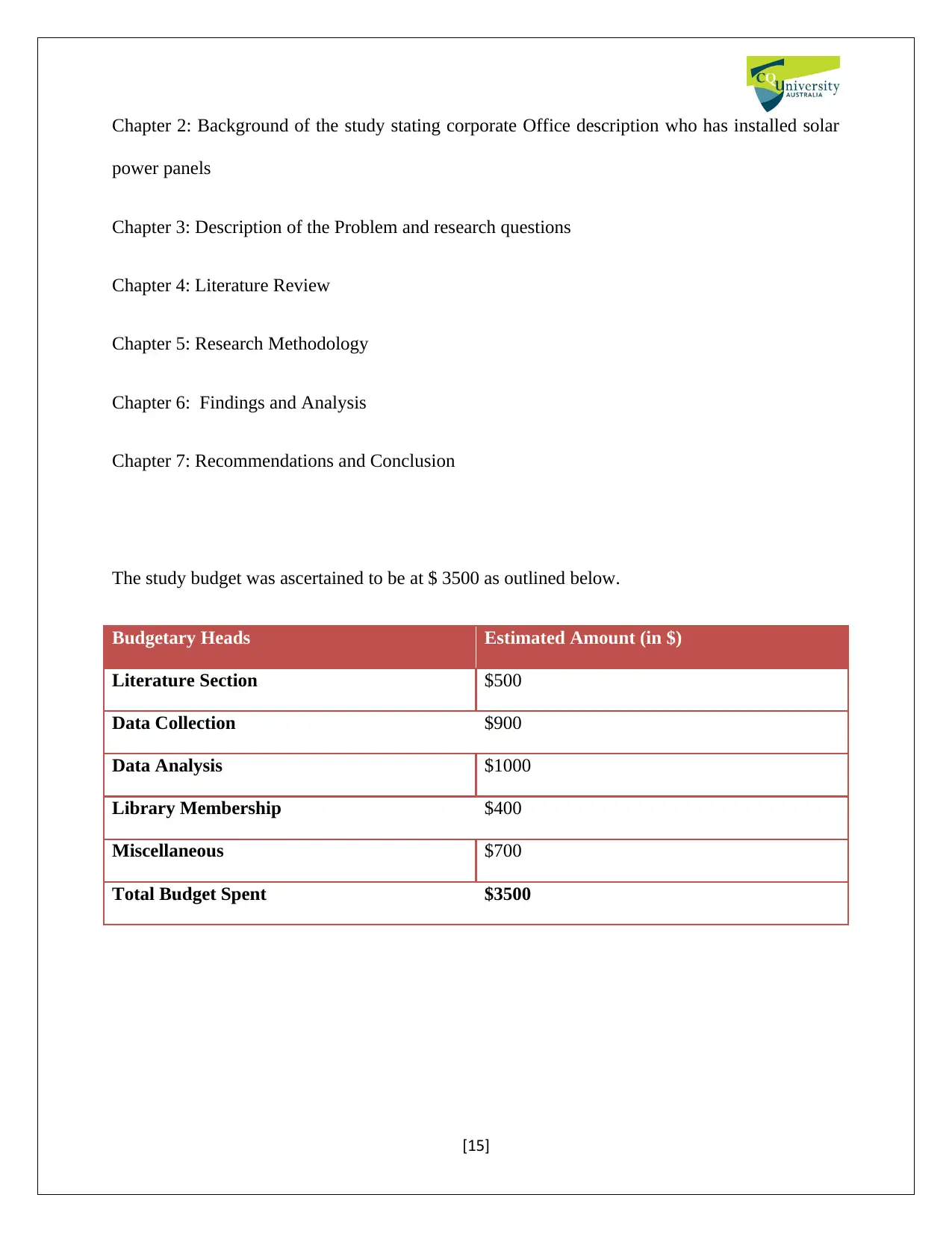
Chapter 2: Background of the study stating corporate Office description who has installed solar
power panels
Chapter 3: Description of the Problem and research questions
Chapter 4: Literature Review
Chapter 5: Research Methodology
Chapter 6: Findings and Analysis
Chapter 7: Recommendations and Conclusion
The study budget was ascertained to be at $ 3500 as outlined below.
Budgetary Heads Estimated Amount (in $)
Literature Section $500
Data Collection $900
Data Analysis $1000
Library Membership $400
Miscellaneous $700
Total Budget Spent $3500
[15]
power panels
Chapter 3: Description of the Problem and research questions
Chapter 4: Literature Review
Chapter 5: Research Methodology
Chapter 6: Findings and Analysis
Chapter 7: Recommendations and Conclusion
The study budget was ascertained to be at $ 3500 as outlined below.
Budgetary Heads Estimated Amount (in $)
Literature Section $500
Data Collection $900
Data Analysis $1000
Library Membership $400
Miscellaneous $700
Total Budget Spent $3500
[15]
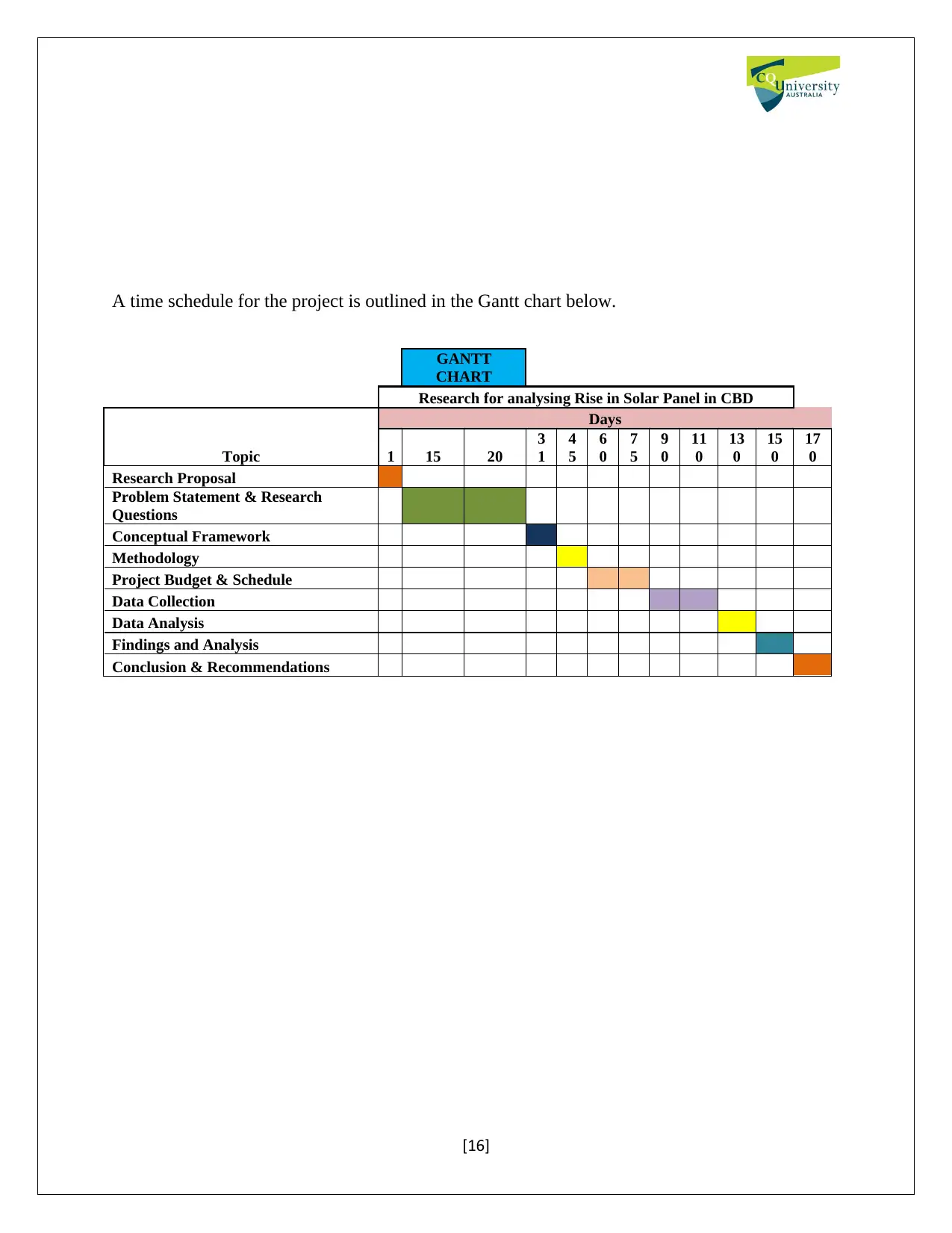
A time schedule for the project is outlined in the Gantt chart below.
GANTT
CHART
Research for analysing Rise in Solar Panel in CBD
Topic
Days
1 15 20
3
1
4
5
6
0
7
5
9
0
11
0
13
0
15
0
17
0
Research Proposal
Problem Statement & Research
Questions
Conceptual Framework
Methodology
Project Budget & Schedule
Data Collection
Data Analysis
Findings and Analysis
Conclusion & Recommendations
[16]
GANTT
CHART
Research for analysing Rise in Solar Panel in CBD
Topic
Days
1 15 20
3
1
4
5
6
0
7
5
9
0
11
0
13
0
15
0
17
0
Research Proposal
Problem Statement & Research
Questions
Conceptual Framework
Methodology
Project Budget & Schedule
Data Collection
Data Analysis
Findings and Analysis
Conclusion & Recommendations
[16]
Secure Best Marks with AI Grader
Need help grading? Try our AI Grader for instant feedback on your assignments.
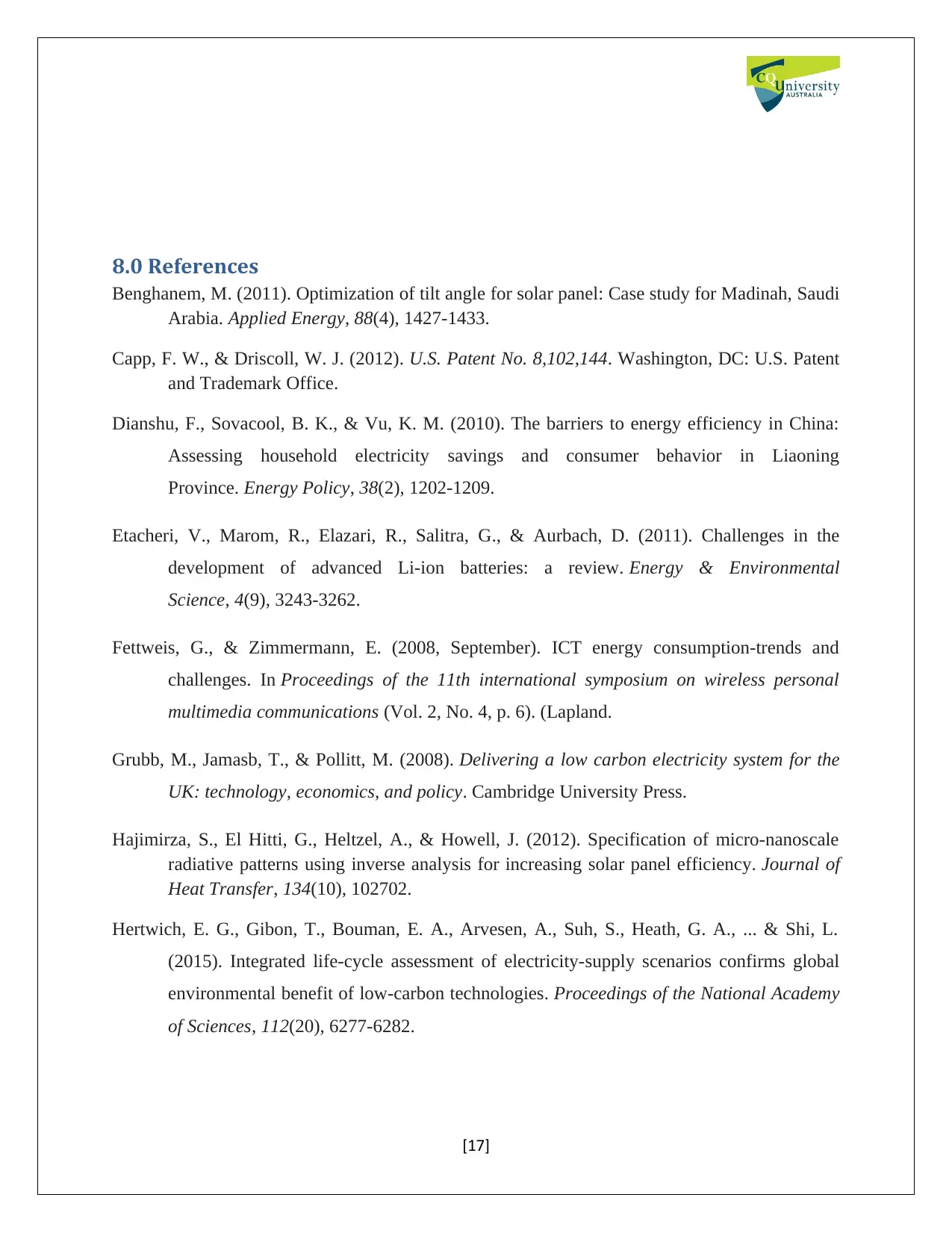
8.0 References
Benghanem, M. (2011). Optimization of tilt angle for solar panel: Case study for Madinah, Saudi
Arabia. Applied Energy, 88(4), 1427-1433.
Capp, F. W., & Driscoll, W. J. (2012). U.S. Patent No. 8,102,144. Washington, DC: U.S. Patent
and Trademark Office.
Dianshu, F., Sovacool, B. K., & Vu, K. M. (2010). The barriers to energy efficiency in China:
Assessing household electricity savings and consumer behavior in Liaoning
Province. Energy Policy, 38(2), 1202-1209.
Etacheri, V., Marom, R., Elazari, R., Salitra, G., & Aurbach, D. (2011). Challenges in the
development of advanced Li-ion batteries: a review. Energy & Environmental
Science, 4(9), 3243-3262.
Fettweis, G., & Zimmermann, E. (2008, September). ICT energy consumption-trends and
challenges. In Proceedings of the 11th international symposium on wireless personal
multimedia communications (Vol. 2, No. 4, p. 6). (Lapland.
Grubb, M., Jamasb, T., & Pollitt, M. (2008). Delivering a low carbon electricity system for the
UK: technology, economics, and policy. Cambridge University Press.
Hajimirza, S., El Hitti, G., Heltzel, A., & Howell, J. (2012). Specification of micro-nanoscale
radiative patterns using inverse analysis for increasing solar panel efficiency. Journal of
Heat Transfer, 134(10), 102702.
Hertwich, E. G., Gibon, T., Bouman, E. A., Arvesen, A., Suh, S., Heath, G. A., ... & Shi, L.
(2015). Integrated life-cycle assessment of electricity-supply scenarios confirms global
environmental benefit of low-carbon technologies. Proceedings of the National Academy
of Sciences, 112(20), 6277-6282.
[17]
Benghanem, M. (2011). Optimization of tilt angle for solar panel: Case study for Madinah, Saudi
Arabia. Applied Energy, 88(4), 1427-1433.
Capp, F. W., & Driscoll, W. J. (2012). U.S. Patent No. 8,102,144. Washington, DC: U.S. Patent
and Trademark Office.
Dianshu, F., Sovacool, B. K., & Vu, K. M. (2010). The barriers to energy efficiency in China:
Assessing household electricity savings and consumer behavior in Liaoning
Province. Energy Policy, 38(2), 1202-1209.
Etacheri, V., Marom, R., Elazari, R., Salitra, G., & Aurbach, D. (2011). Challenges in the
development of advanced Li-ion batteries: a review. Energy & Environmental
Science, 4(9), 3243-3262.
Fettweis, G., & Zimmermann, E. (2008, September). ICT energy consumption-trends and
challenges. In Proceedings of the 11th international symposium on wireless personal
multimedia communications (Vol. 2, No. 4, p. 6). (Lapland.
Grubb, M., Jamasb, T., & Pollitt, M. (2008). Delivering a low carbon electricity system for the
UK: technology, economics, and policy. Cambridge University Press.
Hajimirza, S., El Hitti, G., Heltzel, A., & Howell, J. (2012). Specification of micro-nanoscale
radiative patterns using inverse analysis for increasing solar panel efficiency. Journal of
Heat Transfer, 134(10), 102702.
Hertwich, E. G., Gibon, T., Bouman, E. A., Arvesen, A., Suh, S., Heath, G. A., ... & Shi, L.
(2015). Integrated life-cycle assessment of electricity-supply scenarios confirms global
environmental benefit of low-carbon technologies. Proceedings of the National Academy
of Sciences, 112(20), 6277-6282.
[17]
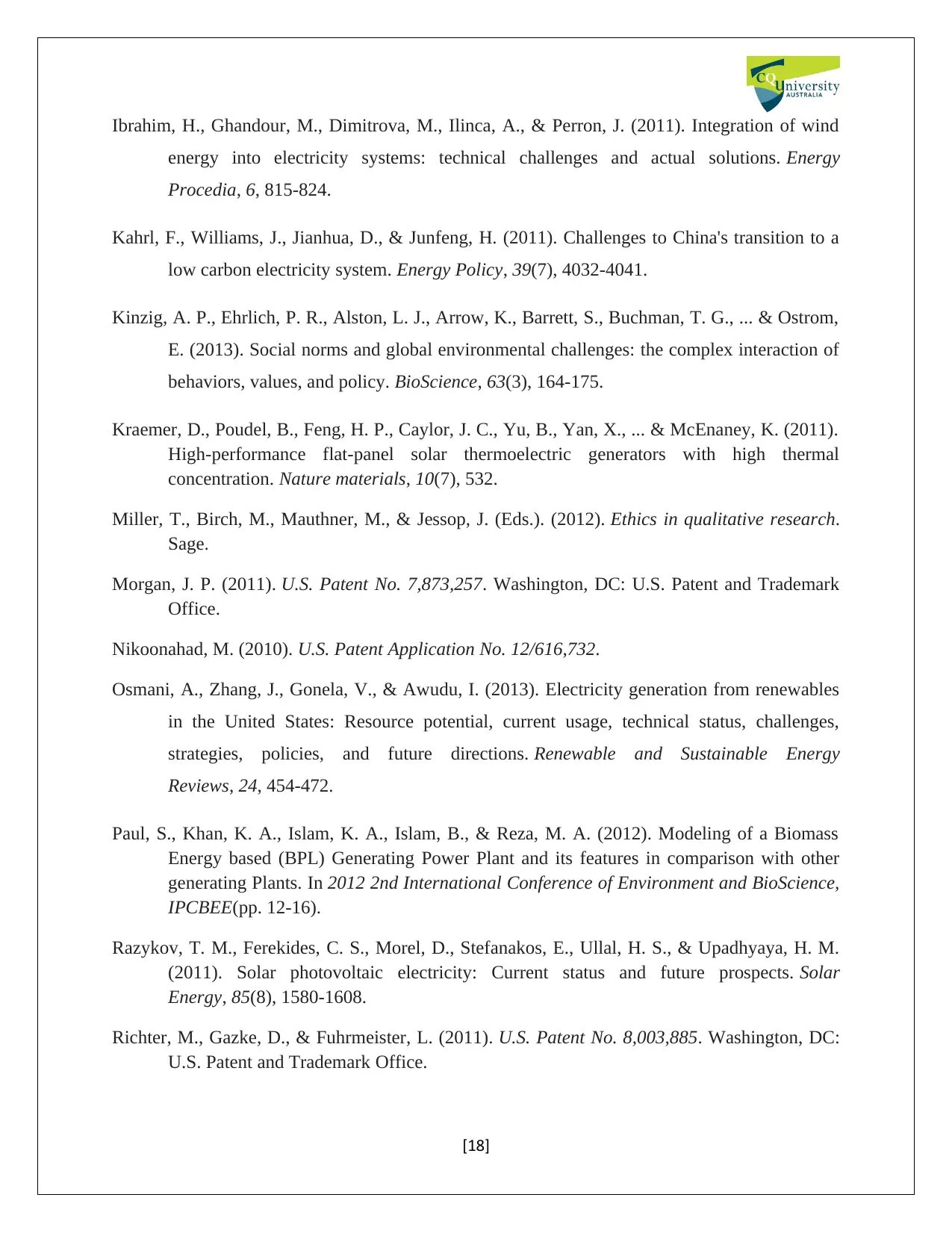
Ibrahim, H., Ghandour, M., Dimitrova, M., Ilinca, A., & Perron, J. (2011). Integration of wind
energy into electricity systems: technical challenges and actual solutions. Energy
Procedia, 6, 815-824.
Kahrl, F., Williams, J., Jianhua, D., & Junfeng, H. (2011). Challenges to China's transition to a
low carbon electricity system. Energy Policy, 39(7), 4032-4041.
Kinzig, A. P., Ehrlich, P. R., Alston, L. J., Arrow, K., Barrett, S., Buchman, T. G., ... & Ostrom,
E. (2013). Social norms and global environmental challenges: the complex interaction of
behaviors, values, and policy. BioScience, 63(3), 164-175.
Kraemer, D., Poudel, B., Feng, H. P., Caylor, J. C., Yu, B., Yan, X., ... & McEnaney, K. (2011).
High-performance flat-panel solar thermoelectric generators with high thermal
concentration. Nature materials, 10(7), 532.
Miller, T., Birch, M., Mauthner, M., & Jessop, J. (Eds.). (2012). Ethics in qualitative research.
Sage.
Morgan, J. P. (2011). U.S. Patent No. 7,873,257. Washington, DC: U.S. Patent and Trademark
Office.
Nikoonahad, M. (2010). U.S. Patent Application No. 12/616,732.
Osmani, A., Zhang, J., Gonela, V., & Awudu, I. (2013). Electricity generation from renewables
in the United States: Resource potential, current usage, technical status, challenges,
strategies, policies, and future directions. Renewable and Sustainable Energy
Reviews, 24, 454-472.
Paul, S., Khan, K. A., Islam, K. A., Islam, B., & Reza, M. A. (2012). Modeling of a Biomass
Energy based (BPL) Generating Power Plant and its features in comparison with other
generating Plants. In 2012 2nd International Conference of Environment and BioScience,
IPCBEE(pp. 12-16).
Razykov, T. M., Ferekides, C. S., Morel, D., Stefanakos, E., Ullal, H. S., & Upadhyaya, H. M.
(2011). Solar photovoltaic electricity: Current status and future prospects. Solar
Energy, 85(8), 1580-1608.
Richter, M., Gazke, D., & Fuhrmeister, L. (2011). U.S. Patent No. 8,003,885. Washington, DC:
U.S. Patent and Trademark Office.
[18]
energy into electricity systems: technical challenges and actual solutions. Energy
Procedia, 6, 815-824.
Kahrl, F., Williams, J., Jianhua, D., & Junfeng, H. (2011). Challenges to China's transition to a
low carbon electricity system. Energy Policy, 39(7), 4032-4041.
Kinzig, A. P., Ehrlich, P. R., Alston, L. J., Arrow, K., Barrett, S., Buchman, T. G., ... & Ostrom,
E. (2013). Social norms and global environmental challenges: the complex interaction of
behaviors, values, and policy. BioScience, 63(3), 164-175.
Kraemer, D., Poudel, B., Feng, H. P., Caylor, J. C., Yu, B., Yan, X., ... & McEnaney, K. (2011).
High-performance flat-panel solar thermoelectric generators with high thermal
concentration. Nature materials, 10(7), 532.
Miller, T., Birch, M., Mauthner, M., & Jessop, J. (Eds.). (2012). Ethics in qualitative research.
Sage.
Morgan, J. P. (2011). U.S. Patent No. 7,873,257. Washington, DC: U.S. Patent and Trademark
Office.
Nikoonahad, M. (2010). U.S. Patent Application No. 12/616,732.
Osmani, A., Zhang, J., Gonela, V., & Awudu, I. (2013). Electricity generation from renewables
in the United States: Resource potential, current usage, technical status, challenges,
strategies, policies, and future directions. Renewable and Sustainable Energy
Reviews, 24, 454-472.
Paul, S., Khan, K. A., Islam, K. A., Islam, B., & Reza, M. A. (2012). Modeling of a Biomass
Energy based (BPL) Generating Power Plant and its features in comparison with other
generating Plants. In 2012 2nd International Conference of Environment and BioScience,
IPCBEE(pp. 12-16).
Razykov, T. M., Ferekides, C. S., Morel, D., Stefanakos, E., Ullal, H. S., & Upadhyaya, H. M.
(2011). Solar photovoltaic electricity: Current status and future prospects. Solar
Energy, 85(8), 1580-1608.
Richter, M., Gazke, D., & Fuhrmeister, L. (2011). U.S. Patent No. 8,003,885. Washington, DC:
U.S. Patent and Trademark Office.
[18]
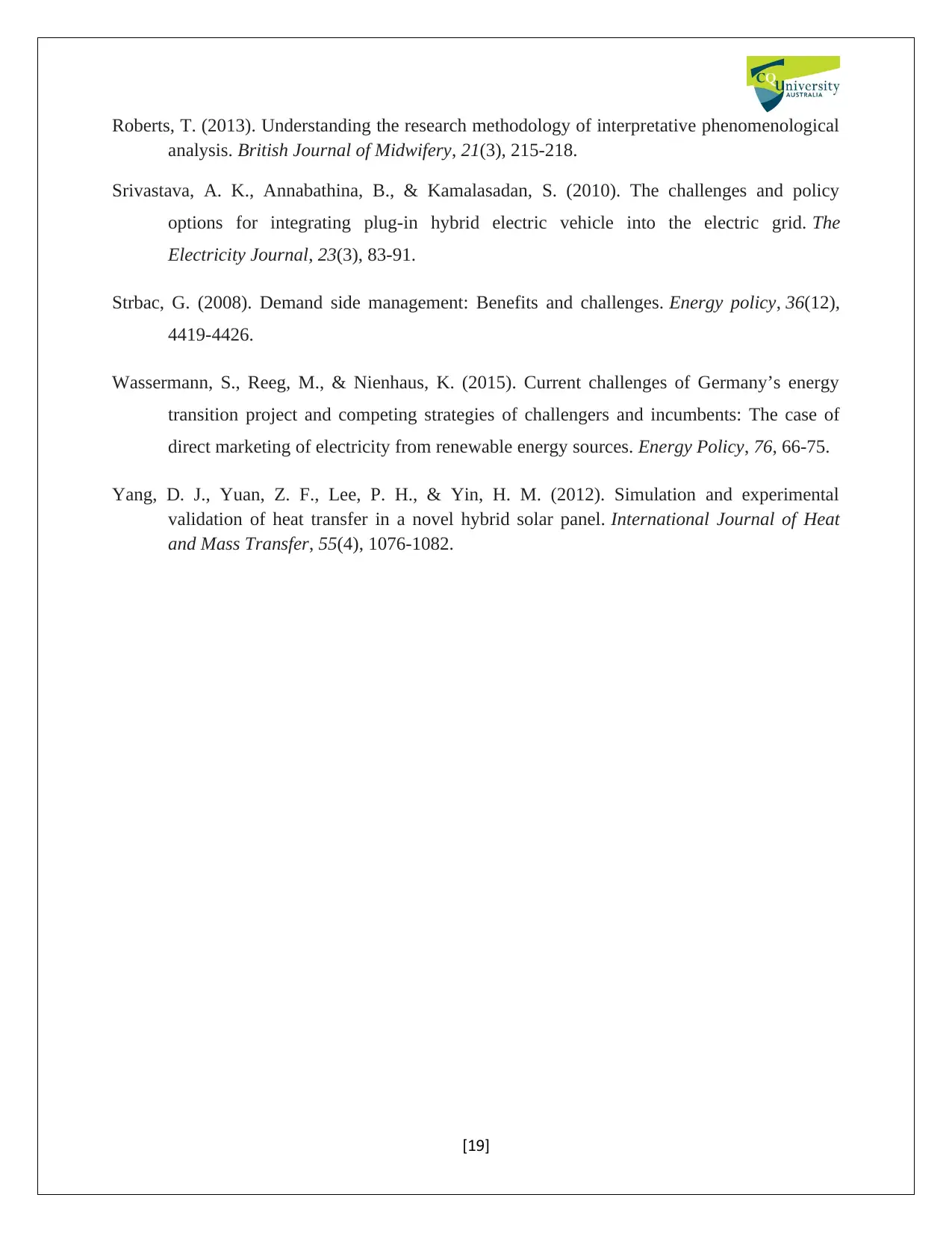
Roberts, T. (2013). Understanding the research methodology of interpretative phenomenological
analysis. British Journal of Midwifery, 21(3), 215-218.
Srivastava, A. K., Annabathina, B., & Kamalasadan, S. (2010). The challenges and policy
options for integrating plug-in hybrid electric vehicle into the electric grid. The
Electricity Journal, 23(3), 83-91.
Strbac, G. (2008). Demand side management: Benefits and challenges. Energy policy, 36(12),
4419-4426.
Wassermann, S., Reeg, M., & Nienhaus, K. (2015). Current challenges of Germany’s energy
transition project and competing strategies of challengers and incumbents: The case of
direct marketing of electricity from renewable energy sources. Energy Policy, 76, 66-75.
Yang, D. J., Yuan, Z. F., Lee, P. H., & Yin, H. M. (2012). Simulation and experimental
validation of heat transfer in a novel hybrid solar panel. International Journal of Heat
and Mass Transfer, 55(4), 1076-1082.
[19]
analysis. British Journal of Midwifery, 21(3), 215-218.
Srivastava, A. K., Annabathina, B., & Kamalasadan, S. (2010). The challenges and policy
options for integrating plug-in hybrid electric vehicle into the electric grid. The
Electricity Journal, 23(3), 83-91.
Strbac, G. (2008). Demand side management: Benefits and challenges. Energy policy, 36(12),
4419-4426.
Wassermann, S., Reeg, M., & Nienhaus, K. (2015). Current challenges of Germany’s energy
transition project and competing strategies of challengers and incumbents: The case of
direct marketing of electricity from renewable energy sources. Energy Policy, 76, 66-75.
Yang, D. J., Yuan, Z. F., Lee, P. H., & Yin, H. M. (2012). Simulation and experimental
validation of heat transfer in a novel hybrid solar panel. International Journal of Heat
and Mass Transfer, 55(4), 1076-1082.
[19]
1 out of 19
Related Documents
Your All-in-One AI-Powered Toolkit for Academic Success.
+13062052269
info@desklib.com
Available 24*7 on WhatsApp / Email
![[object Object]](/_next/static/media/star-bottom.7253800d.svg)
Unlock your academic potential
© 2024 | Zucol Services PVT LTD | All rights reserved.




